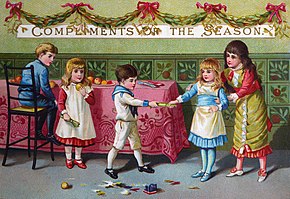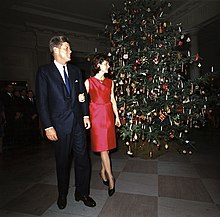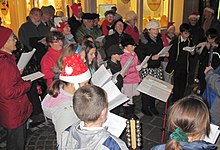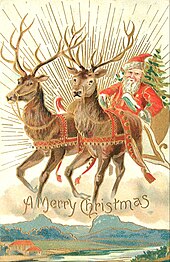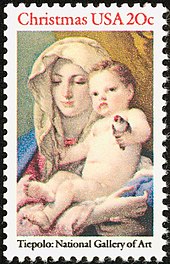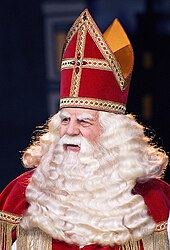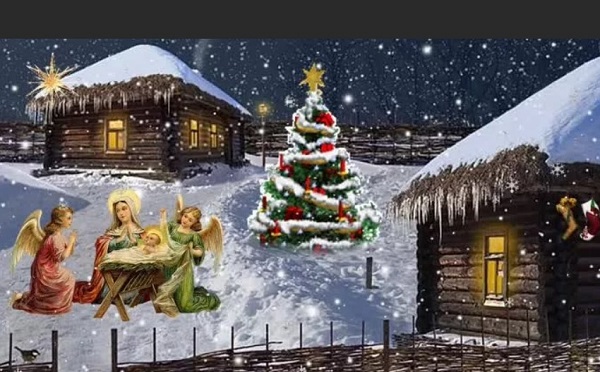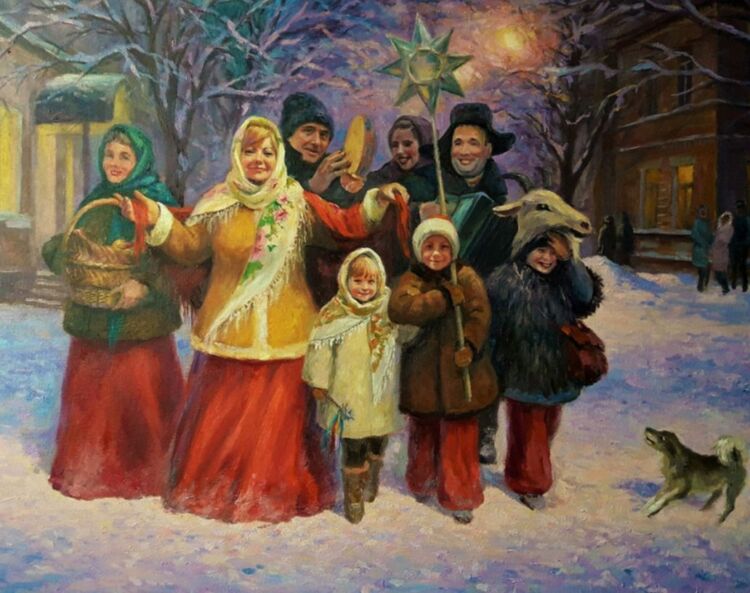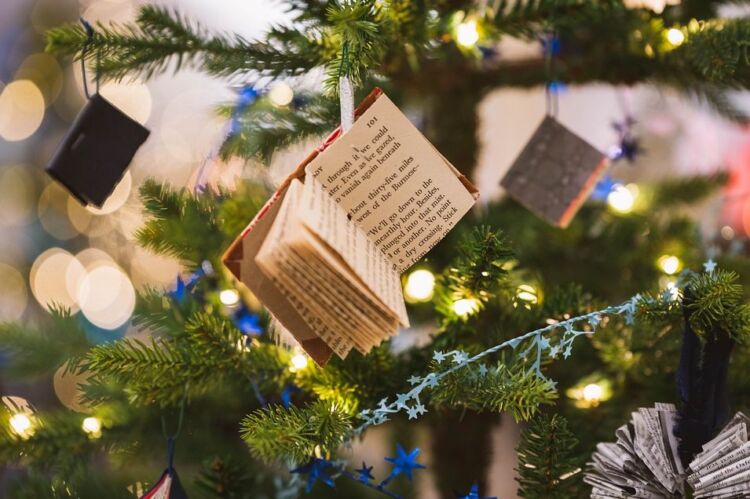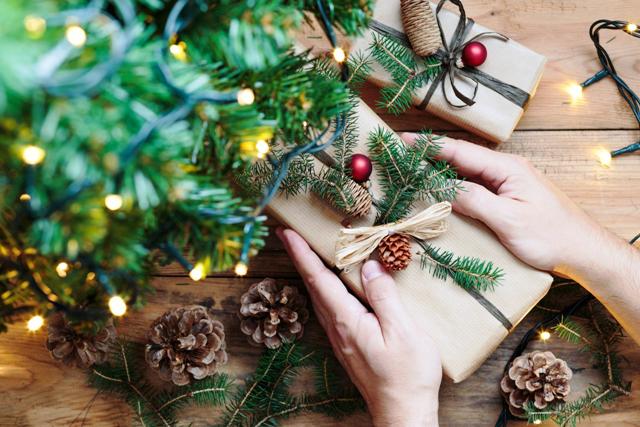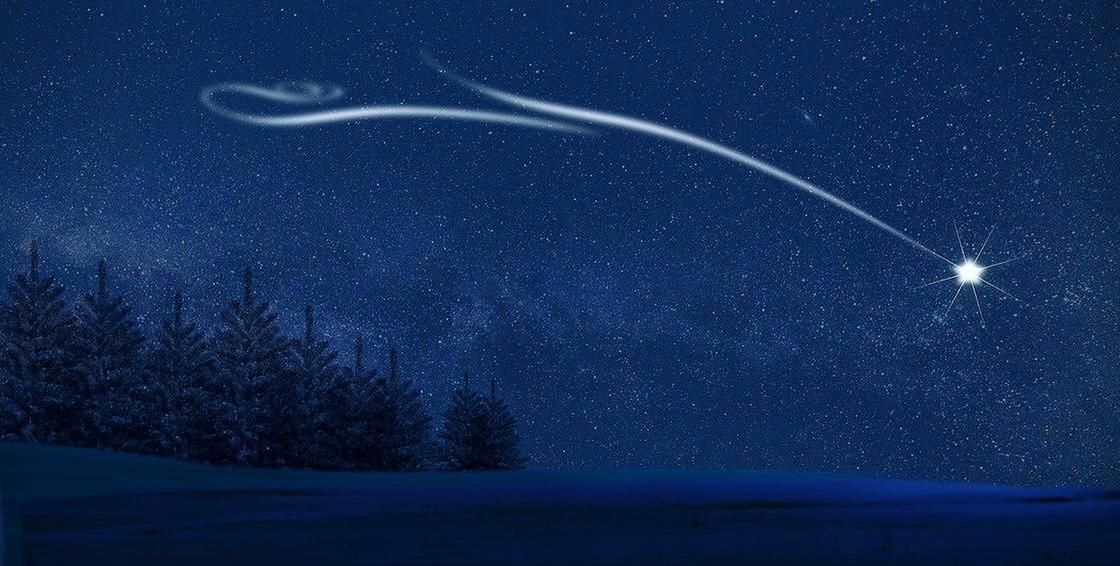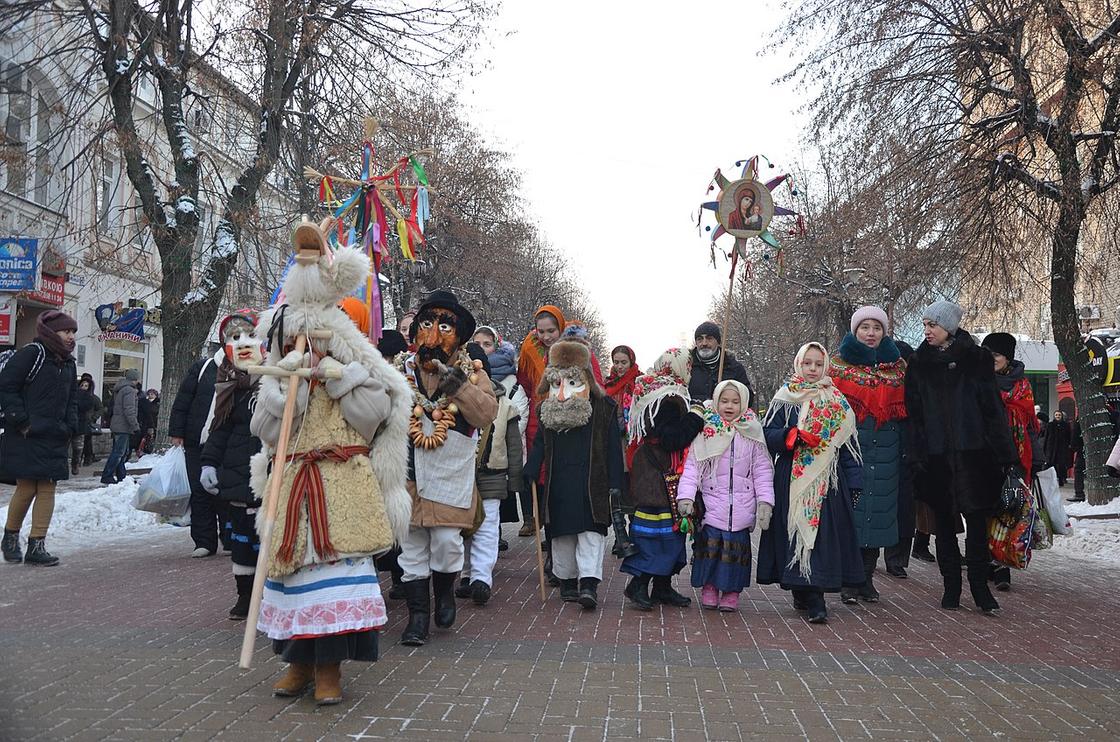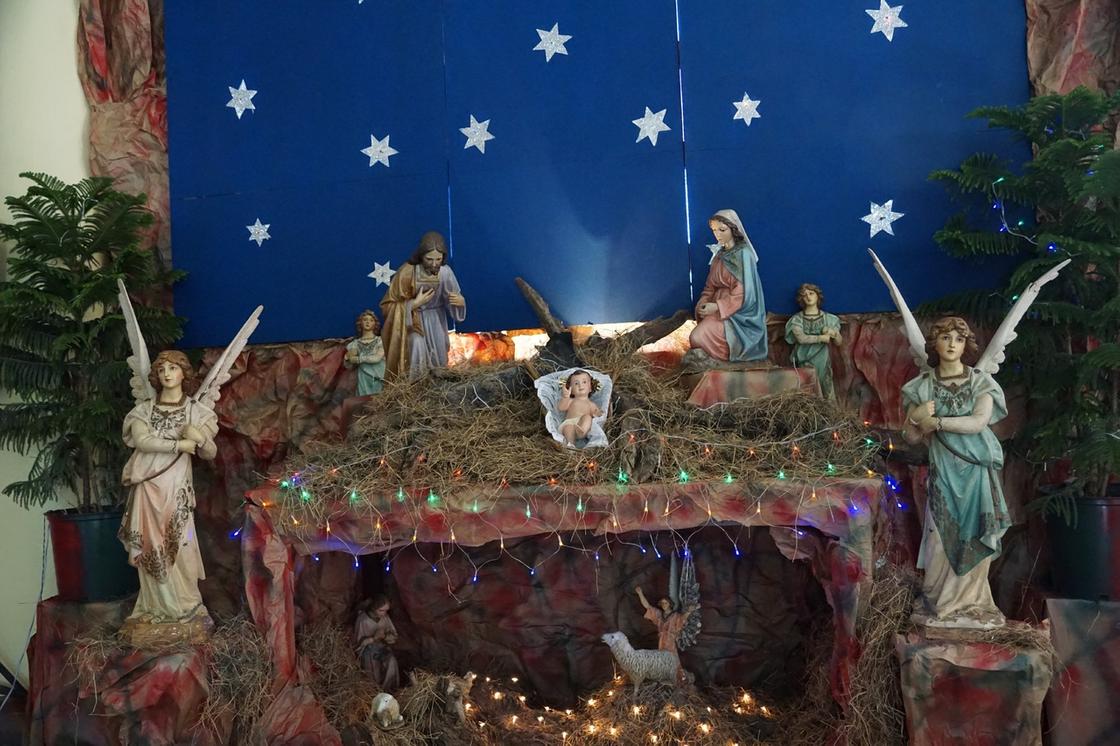Рождественские праздники
Рождественские праздники или Святки можно смело назвать самыми любимыми и веселыми. Их с нетерпением ждут и взрослые, и дети. А все потому, что именно с этими праздниками связано множество красивых обрядов и традиций.
Новогодние и рождественские праздники
Зимние празднества начинаются со встречи в ночь с 31 декабря на 1 января Нового года. Наряжается елка, готовится обильное угощение. Нередко, празднование может проходить вне дома, например, в ресторане или кафе. Затем следуют Рождество и Крещение, между которыми в народе принято еще отмечать так называемый старый Новый год (встречу Нового года по старому календарю) или Щедрый вечер (в некоторых регионах – Меланку). И если встреча Нового года это, скорее, светское мероприятие, то Рождество — сугубо домашний праздник с глубокими православными корнями. Поэтому немного об истории Рождественских праздников. Эти праздники посвящены рождению Иисуса Христа, его крещению в водах реки Иордан и поклонению волхвов. Между Рождеством и Крещением Христианской Церковью (аж в 451 году) установлены 12 праздничных, святых, дней. Поэтому этот период и называется Святками. По церковным канонам до Рождества соблюдался пост, нельзя было петь, веселиться, совершать различные обряды. Но, в народе эти догмы никогда строго не соблюдались. Многие занимались и занимаются до сих пор святочными гаданиями, а при встрече Нового года мы накрываем богатый стол. Но, тем не менее, некоторые традиции рождественских праздников сохранены и соблюдаются по сей день. Так, вечером в канун Рождества (6 января), в так называемый Сочельник, накрывается стол к семейному ужину. На стол стелиться белоснежная скатерть, под которую укладывается сено (память о том, что Иисус родился в яслях). На стол подается 12 постных блюд (по числу первых апостолов), среди которых обязательно должна быть кутья (сочиво – откуда и название Сочельник). Мясные блюда разрешено есть на само Рождество (7 января) после утренней литургии. К трапезе приступают после восхода первой звезды (память о Вифлеемской звезде, возвестившей 
На Меланку (встреча старого Нового года) также устраивается богатое (щедрое) застолье, а в ночь с 13 на 14 января ходят щедровать – почему и вечер называется Щедрым. На Крещение (19 января) принято окунаться в прорубь (иордань), вырубленную в виде креста, или запастись освященной водой в храме.
Понятно, что в современных условиях нет строго соблюдения всех догм. Но, если возникнет вопрос, как провести рождественские праздники, вспомните и о народных традициях.
Статьи по теме:
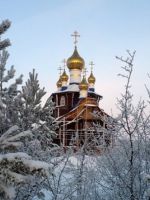
Каждый месяц календаря богат христианскими праздниками, и декабрь — не исключение. Какие православные праздники отмечаются в декабре, мы расскажем в статье. |
Это один из самых великих православных праздников, отмечаемых осенью. Об истории праздника Михаила, а также о его традициях мы расскажем в нашей новой статье. |
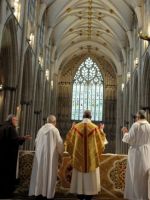
Несмотря на множество общих традиций и обрядов, католический мир очень отличается от православного, в том числе и праздниками. Все о католических праздниках и их обычаях мы расскажем в статье. |
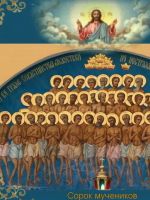
Это один из самых важных праздников христианского мира. Как отмечается великий праздник Сорок Святых в традициях православия, мы расскажем в статье. |
Юрий Рубан
Как известно, богослужебное чествование важнейших праздников не ограничивается одним днем. В первую очередь это относится к торжествам, выражающим важнейшие догматы Христианства как религии Спасения – к Богоявлению, т. е. явлению Бога во плоти, и Его Воскресению из мертвых. Воскресению Христову (или Пасхе) посвящен весьма продолжительный и тщательно разработанный календарный период, именуемый «Пасхальным циклом».
Рождественский цикл по разным причинам не получил такого законченного оформления. Древние богослужебные источники свидетельствуют, что из некоего «синтетического» праздника, который греки называли Тэофания, или Епифания (Богоявление, или Явление), включавшего в себя целый ряд смысловых аспектов, вырастает постепенно цикл исторических воспоминаний: Рождество в Вифлееме, Крещение на Иордане, Сретение (Встреча) в Иерусалимском храме. В него включены и менее торжественные праздники – производные от этих основных (смотрите ниже). В настоящее время эти торжества воспринимаются нами как отдельные по смыслу богослужебные воспоминания. Но в древности Тэофанию (Епифанию) праздновали сорок дней (как мы сейчас празднуем Пасху), а своеобразным «отданием» праздников рождественского цикла был праздник Сретения Господня. Кстати, далеко не все знают, что в старых богослужебных книгах под 25 декабря, наряду с обычным названием праздника Рождества, помещался подзаголовок: «Пасха. Праздник тридневный»! Современный православный цикл рождественских праздников и воспоминаний можно представить в таком виде.
Неделя святых праотец (праотцов) (предпоследнее воскресенье перед Рождеством Христовым). Церковь воспоминает всех родоначальников (греч. патриархов) богоизбранного народа – от Адама до Иосифа Обручника; вместе с ними вспоминаются «проповедавшие Христа» ветхозаветные пророки и вообще все библейские праведники.
Неделя святых отец (отцов) (в воскресенье перед Рождеством). Церковь вновь воспоминает всех ветхозаветных святых, но особо прославляются предки Иисуса Христа по плоти. Поэтому в Евангельском чтении на Литургии приводится родословная (генеалогия) Иисуса Христа.
Рождество Господа Бога и Спаса нашего Иисуса Христа [в 5508 г. от Сотворения мира, в царствование Кесаря Августа, в Вифлееме Иудейском]. Таково современное название праздника; в квадратных скобках – дополнение по старым месяцесловам. Более точное в богословском аспекте название, на которое нам следует обратить особое внимание, таково: «Еже по плоти (kata sarka) (!) Рождество Господа Бога и Спаса нашего Иисуса Христа» (так в славянской Минее, это буквальный перевод с греческого). – (25 декабря / 7 января).
Собор Пресвятой Богородицы (26 декабря / 8 января). На следующий день после празднования Рождества Церковь устраивает торжественное «собрание» (слав. собор) – созывает верующих для благодарственного прославления Пресвятой Девы, послужившей великому таинству воплощения и вочеловечения Сына Божия. Отсюда и название праздника.
Память святых и праведных Иосифа Обручника, царя Давида и Иакова, брата Господня (в первое воскресенье после Рождества; если же Рождество приходится на воскресенье, то их память совершается на следующий день, вместе с Собором Богородицы).
Память Святых младенец четыренадесяти (четырнадцати) тысяч, иже в Вифлееме от Ирода избиенных (29 декабря / 11 января).
Обрезание Господа Бога и Спаса нашего Иисуса Христа (1/14 января).
Святое Богоявление. Крещение Господа Бога и Спаса нашего Иисуса Христа (6/19 января).
Собор Предтечи и Крестителя Господня Иоанна (7/20 января).
Сретение Господа нашего Иисуса Христа (2/15 февраля).
Память Прав. Симеона Богоприимца и Анны Пророчицы (3/16 февраля).
Children depicted pulling a Christmas cracker in a 19th century English Christmas card
Christmas traditions include a variety of customs, religious practices, rituals, and folklore associated with the celebration of Christmas. Many of these traditions vary by country or region, while others are practiced in a virtually identical manner across the world.
Traditions associated with the Christmas holiday are diverse in their origins and nature, with some having an exclusively Christian character with origins from within the religion, while others have been described as more cultural or secular in nature and have originated from outside the realm of Christian influence. Christmas traditions have also changed and evolved significantly in the centuries since Christmas was first instituted as a holiday, with celebrations often taking on an entirely different quality or atmosphere depending on the time period and geographical region.
Church attendance[edit]
Christmas Day (inclusive of its vigil, Christmas Eve), is a Festival in the Lutheran Church, a Solemnity in the Roman Catholic Church, and a Principal Feast of the Anglican Communion. Other Christian denominations do not rank their feast days but nevertheless place importance on Christmas Eve/Christmas Day, as with other Christian feasts like Easter, Ascension Day, and Pentecost.[1] As such, for Christians, attending a Christmas Eve or Christmas Day church service plays an important part in the recognition of the Christmas season. Christmas, along with Easter, is the period of highest annual church attendance. A 2010 survey by Lifeway Christian Resources found that six in ten Americans attend church services during this time.[2] In the United Kingdom, the Church of England reported an estimated attendance of 2.5 million people at Christmas services in 2015.[3]
Decorations[edit]
A typical Neapolitan presepe or presepio, or Nativity scene. Local crèches are renowned for their ornate decorations and symbolic figurines, often mirroring daily life.
The practice of putting up special decorations at Christmas has a long history. In the 15th century, it was recorded that in London it was the custom at Christmas for every house and all the parish churches to be «decked with holm, ivy, bays, and whatsoever the season of the year afforded to be green».[4] The heart-shaped leaves of ivy were said to symbolize the coming to earth of Jesus, while holly was seen as protection against pagans and witches, its thorns and red berries held to represent the Crown of Thorns worn by Jesus at the crucifixion and the blood he shed.[5][6]
Clifton Mill in Clifton, Ohio is the site of this Christmas display with over 3.5 million lights.
Nativity scenes are known from 10th-century Rome. They were popularised by Saint Francis of Assisi from 1223, quickly spreading across Europe.[7] Different types of decorations developed across the Christian world, dependent on local tradition and available resources, and can vary from simple representations of the crib to far more elaborate sets – renowned manger scene traditions include the colourful Kraków szopka in Poland,[8] which imitate Kraków’s historical buildings as settings, the elaborate Italian presepi (Neapolitan, Genoese and Bolognese),[9][10][11][12] or the Provençal crèches in southern France, using hand-painted terracotta figurines called santons.[13] In certain parts of the world, notably Sicily, living nativity scenes following the tradition of Saint Francis are a popular alternative to static crèches.[14][15][16] The first commercially produced decorations appeared in Germany in the 1860s, inspired by paper chains made by children.[17] In countries where a representation of the Nativity scene is very popular, people are encouraged to compete and create the most original or realistic ones. Within some families, the pieces used to make the representation are considered a valuable family heirloom.
The traditional colors of Christmas decorations are red, green, and gold. Red symbolizes the blood of Jesus, which was shed in his crucifixion, while green symbolizes eternal life, and in particular the evergreen tree, which does not lose its leaves in the winter, and gold is the first color associated with Christmas, as one of the three gifts of the Magi, symbolizing royalty.[6]
The official White House Christmas tree for 1962, displayed in the Entrance Hall and presented by John F. Kennedy and his wife Jackie.
The Christmas tree was first used by German Lutherans in the 16th century, with records indicating that a Christmas tree was placed in the Cathedral of Strassburg in 1539, under the leadership of the Protestant Reformer, Martin Bucer.[18][19] In the United States, these «German Lutherans brought the decorated Christmas tree with them; the Moravians put lighted candles on those trees.»[20][21] When decorating the Christmas tree, many individuals place a star at the top of the tree symbolizing the Star of Bethlehem, a fact recorded by The School Journal in 1897.[22][23] Professor David Albert Jones of Oxford University writes that in the 19th century, it became popular for people to also use an angel to top the Christmas tree in order to symbolize the angels mentioned in the accounts of the Nativity of Jesus.[24] The Christmas tree is considered by some as Christianisation of pagan tradition and ritual surrounding the Winter Solstice, which included the use of evergreen boughs, and an adaptation of pagan tree worship;[25] according to eighth-century biographer Æddi Stephanus, Saint Boniface (634–709), who was a missionary in Germany, took an axe to an oak tree dedicated to Thor and pointed out a fir tree, which he stated was a more fitting object of reverence because it pointed to heaven and it had a triangular shape, which he said was symbolic of the Trinity.[26] The English language phrase «Christmas tree» is first recorded in 1835[27] and represents an importation from the German language.[25][28][29]
From Germany the custom was introduced to Britain, first via Queen Charlotte, wife of George III, and then more successfully by Prince Albert during the reign of Queen Victoria. By 1841 the Christmas tree had become even more widespread throughout Britain.[30] By the 1870s, people in the United States had adopted the custom of putting up a Christmas tree.[31] Christmas trees may be decorated with lights and ornaments.
Since the 16th century, the poinsettia, a native plant from Mexico, has been associated with Christmas carrying the Christian symbolism of the Star of Bethlehem; in that country it is known in Spanish as the Flower of the Holy Night.[32][33] Other popular holiday plants include holly, mistletoe, red amaryllis, and Christmas cactus. Along with a Christmas tree, the interior of a home may be decorated with these plants, along with garlands and evergreen foliage. The display of Christmas villages has also become a tradition in many homes during this season. The outside of houses may be decorated with lights and sometimes with illuminated sleighs, snowmen, and other Christmas figures. Mistletoe features prominently in European myth and folklore (for example the legend of Baldr), it is an evergreen parasitic plant which grows on trees, especially apple and poplar, and turns golden when it is dried. It is customary to hang a sprig of mistletoe in the house at Christmas, and anyone standing underneath it may be kissed. Mistletoe has sticky white berries, one of which was traditionally removed whenever someone was kissed under it. This is probably a fertility ritual. The mistletoe berry juice resembles semen.[34]
Outdoor Christmas decoration and lighting
Other traditional decorations include bells, candles, candy canes, stockings, wreaths, and angels. Both the displaying of wreaths and candles in each window are a more traditional Christmas display. The concentric assortment of leaves, usually from an evergreen, make up Christmas wreaths and are designed to prepare Christians for the Advent season. Candles in each window are meant to demonstrate the fact that Christians believe that Jesus Christ is the ultimate light of the world.[35]
Christmas lights and banners may be hung along streets, music played from speakers, and Christmas trees placed in prominent places.[36] It is common in many parts of the world for town squares and consumer shopping areas to sponsor and display decorations. Rolls of brightly colored paper with secular or religious Christmas motifs are manufactured for the purpose of wrapping gifts. In some countries, Christmas decorations are traditionally taken down on Twelfth Night.
Nativity play[edit]
For the Christian celebration of Christmas, the viewing of the Nativity play is one of the oldest Christmastime traditions, with the first reenactment of the Nativity of Jesus taking place in A.D. 1223.[37] In that year, Francis of Assisi assembled a Nativity scene outside of his church in Italy and children sang Christmas carols celebrating the birth of Jesus.[37] Each year, this grew larger and people travelled from afar to see Francis’ depiction of the Nativity of Jesus that came to feature drama and music.[37] Nativity plays eventually spread throughout all of Europe, where they remain popular. Christmas Eve and Christmas Day church services often came to feature Nativity plays, as did schools and theatres.[37] In France, Germany, Mexico and Spain, Nativity plays are often reenacted outdoors in the streets.[37]
Music and carols[edit]
The earliest extant specifically Christmas hymns appear in fourth-century Rome. Latin hymns such as «Veni redemptor gentium», written by Ambrose, Archbishop of Milan, were austere statements of the theological doctrine of the Incarnation in opposition to Arianism. «Corde natus ex Parentis» («Of the Father’s love begotten») by the Spanish poet Prudentius (d. 413) is still sung in some churches today.[38] In the 9th and 10th centuries, the Christmas «Sequence» or «Prose» was introduced in North European monasteries, developing under Bernard of Clairvaux into a sequence of rhymed stanzas. In the 12th century the Parisian monk Adam of St. Victor began to derive music from popular songs, introducing something closer to the traditional Christmas carol.
By the 13th century, in France, Germany, and particularly, Italy, under the influence of Francis of Assisi, a strong tradition of popular Christmas songs in the native language developed.[39] Christmas carols in English first appear in a 1426 work of John Awdlay, a Shropshire chaplain, who lists twenty-five «caroles of Cristemas», probably sung by groups of wassailers, who went from house to house.[40]
The songs now known specifically as carols were originally communal folk songs sung during celebrations such as «harvest tide» as well as Christmas. It was only later that carols began to be sung in church. Traditionally, carols have often been based on medieval chord patterns, and it is this that gives them their uniquely characteristic musical sound. Some carols like «Personent hodie», «Good King Wenceslas», and «The Holly and the Ivy» can be traced directly back to the Middle Ages. They are among the oldest musical compositions still regularly sung. «Adeste Fideles» (O Come all ye faithful) appears in its current form in the mid-18th century, although the words may have originated in the 13th century.
Singing of carols initially suffered a decline in popularity after the Protestant Reformation in northern Europe, although some Reformers, like Martin Luther, wrote carols and encouraged their use in worship. Carols largely survived in rural communities until the revival of interest in popular songs in the 19th century. The 18th-century English reformer Charles Wesley understood the importance of music to worship. In addition to setting many psalms to melodies, which were influential in the Great Awakening in the United States, he wrote texts for at least three Christmas carols. The best known was originally entitled «Hark! How All the Welkin Rings», later renamed «Hark! the Herald Angels Sing».[41]
Performed by the U.S. Army Band Chorus
Felix Mendelssohn wrote a melody adapted to fit Wesley’s words. In Austria in 1818 Mohr and Gruber made a major addition to the genre when they composed «Silent Night» for the St. Nicholas Church, Oberndorf. William Sandys’ Christmas Carols Ancient and Modern (1833) contained the first appearance in print of many now-classic English carols, and contributed to the mid-Victorian revival of the festival.[42]
Completely secular Christmas seasonal songs emerged in the late 18th century. «Deck the Halls» dates from 1784, and the American «Jingle Bells» was copyrighted in 1857. In the 19th and 20th century, African American spirituals and songs about Christmas, based in their tradition of spirituals, became more widely known. An increasing number of seasonal holidays songs were commercially produced in the 20th century, including jazz and blues variations. In addition, there was a revival of interest in early music, from groups singing folk music, such as The Revels, to performers of early medieval and classical music. John Rutter has composed many carols including «All Bells in Paradise», «Angels’ Carol», «Candlelight Carol», «Donkey Carol», «Jesus Child», «Shepherd’s Pipe Carol» and «Star Carol».
Traditional cuisine[edit]
A special Christmas family meal is traditionally an important part of the holiday’s celebration, and the food that is served varies greatly from country to country. Some regions have special meals for Christmas Eve, such as Sicily, where 12 kinds of fish are served. In the United Kingdom and countries influenced by its traditions, a standard Christmas meal includes turkey, goose or other large bird, gravy, potatoes, vegetables, sometimes bread and cider. Special desserts are also prepared, such as Christmas pudding, mince pies, fruit cake and Yule log cake.[43][44]
Christmas table in Serbia
In Poland and other parts of eastern Europe and Scandinavia, fish often is used for the traditional main course, but richer meat such as lamb is increasingly served. In Sweden it is common with a special variety of smörgåsbord, where ham, meatballs and herring play a prominent role. In Germany, France, and Austria, goose and pork are favored. Beef, ham, and chicken in various recipes are popular throughout the world. The Maltese traditionally serve Imbuljuta tal-Qastan,[45] a chocolate and chestnuts beverage, after Midnight Mass and throughout the Christmas season. Slovenes prepare the traditional Christmas bread potica, bûche de Noël in France, panettone in Italy, and elaborate tarts and cakes. The eating of sweets and chocolates has become popular worldwide, and sweeter Christmas delicacies include the German stollen, marzipan cake or candy, and Jamaican rum fruit cake. As one of the few fruits traditionally available to northern countries in winter, oranges have been long associated with special Christmas foods. Eggnog is a sweetened dairy-based beverage traditionally made with milk, cream, sugar, and whipped eggs (which gives it a frothy texture). Spirits such as brandy, rum or bourbon are often added. The finished serving is often garnished with a sprinkling of ground cinnamon or nutmeg.
Cards[edit]
A 1907 Christmas card with Santa and some of his reindeer
Christmas cards are illustrated messages of greeting exchanged between friends and family members during the weeks preceding Christmas Day. The traditional greeting reads «wishing you a Merry Christmas and a Happy New Year», much like that of the first commercial Christmas card, produced by Sir Henry Cole in London in 1843.[46] The custom of sending them has become popular among a wide cross-section of people with the emergence of the modern trend towards exchanging E-cards.
Christmas cards are purchased in considerable quantities, and feature artwork, commercially designed and relevant to the season. The content of the design might relate directly to the Christmas narrative, with depictions of the Nativity of Jesus, or Christian symbols such as the Star of Bethlehem, or a white dove, which can represent both the Holy Spirit and Peace on Earth. Other Christmas cards are more secular and can depict Christmas traditions, mythical figures such as Santa Claus, objects directly associated with Christmas such as candles, holly and baubles, or a variety of images associated with the season, such as Christmastide activities, snow scenes and the wildlife of the northern winter. There are even humorous cards and genres depicting nostalgic scenes of the past such as crinolined shoppers in idealized 19th-century streetscapes.
Some prefer cards with a poem, prayer, or Biblical verse; while others distance themselves from religion with an all-inclusive «Season’s greetings».
Commemorative stamps[edit]
A number of nations have issued commemorative stamps at Christmastide. Postal customers will often use these stamps to mail Christmas cards, and they are popular with philatelists. These stamps are regular postage stamps, unlike Christmas seals, and are valid for postage year-round. They usually go on sale some time between early October and early December, and are printed in considerable quantities.
Gift giving[edit]
Christmas gifts under a Christmas tree
The exchanging of gifts is one of the core aspects of the modern Christmas celebration, making it the most profitable time of year for retailers and businesses throughout the world. On Christmas, people exchange gifts based on the Christian tradition associated with Saint Nicholas,[47] and the gifts of gold, frankincense, and myrrh which were given to the baby Jesus by the Magi.[48][49] The practice of gift giving in the Roman celebration of Saturnalia may have influenced Christian Christmas customs, but on the other hand the Christian «core dogma of the Incarnation, however, solidly established the giving and receiving of gifts as the structural principle of that recurrent yet unique event», because it was the Biblical Magi, «together with all their fellow men, who received the gift of God through man’s renewed participation in the divine life.»[50]
Gift-bearing figures[edit]
Christmas gift-bringers in Europe
A number of figures are associated with Christmas and the seasonal giving of gifts. Among these are Father Christmas, also known as Santa Claus (derived from the Dutch for Saint Nicholas), Père Noël, and the Weihnachtsmann; Saint Nicholas or Sinterklaas; the Christkind; Kris Kringle; Joulupukki; tomte/nisse; Babbo Natale; Saint Basil; and Ded Moroz. The Scandinavian tomte (also called nisse) is sometimes depicted as a gnome instead of Santa Claus.
The best known of these figures today is red-dressed Santa Claus, of diverse origins. The name Santa Claus can be traced back to the Dutch Sinterklaas, which means simply Saint Nicholas. Nicholas was a 4th-century Greek bishop of Myra, a city in the Roman province of Lycia, whose ruins are 3 kilometres (1.9 mi) from modern Demre in southwest Turkey.[52][53] Among other saintly attributes, he was noted for the care of children, generosity, and the giving of gifts. His feast day, December 6, came to be celebrated in many countries with the giving of gifts.[54]
Saint Nicholas traditionally appeared in bishop’s attire, accompanied by helpers, inquiring about the behaviour of children during the past year before deciding whether they deserved a gift or not. By the 13th century, Saint Nicholas was well known in the Netherlands, and the practice of gift-giving in his name spread to other parts of central and southern Europe. During the Reformation in 16th–17th-century Europe, many Protestants changed the gift bringer to the Christ Child or Christkindl, corrupted in English to Kris Kringle, and the date of giving gifts changed from December 6 to Christmas Eve.[54]
The modern popular image of Santa Claus, however, was created in the United States, and in particular in New York. The transformation was accomplished with the aid of notable contributors including Washington Irving and the German-American cartoonist Thomas Nast (1840–1902). Following the American Revolutionary War, some of the inhabitants of New York City sought out symbols of the city’s non-English past. New York had originally been established as the Dutch colonial town of New Amsterdam and the Dutch Sinterklaas tradition was reinvented as Saint Nicholas.[55]
In 1809, the New-York Historical Society convened and retroactively named Sancte Claus the patron saint of Nieuw Amsterdam, the Dutch name for New York City.[56] At his first American appearance in 1810, Santa Claus was drawn in bishops’ robes. However, as new artists took over, Santa Claus developed more secular attire.[57] Nast drew a new image of «Santa Claus» annually, beginning in 1863. By the 1880s, Nast’s Santa had evolved into the modern vision of the figure, perhaps based on the English figure of Father Christmas. The image was standardized by advertisers in the 1920s[58] and continues through the present day.[59][60]
Father Christmas, a jolly, stout, bearded man who typified the spirit of good cheer at Christmas, predates the Santa Claus character. He is first recorded in early 17th century England, but was associated with holiday merrymaking and drunkenness rather than the bringing of gifts.[27] In Victorian Britain, his image was remade to match that of Santa. The French Père Noël evolved along similar lines, eventually adopting the Santa image. In Italy, Babbo Natale acts as Santa Claus, while La Befana is the bringer of gifts and arrives on the eve of the Epiphany. It is said that La Befana set out to bring the baby Jesus gifts, but got lost along the way. Now, she brings gifts to all children. In some cultures Santa Claus is accompanied by Knecht Ruprecht, or Black Peter. In other versions, elves make the toys. His wife is referred to as Mrs. Claus.
There has been some opposition to the narrative of the American evolution of Saint Nicholas into the modern Santa. It has been claimed that the Saint Nicholas Society was not founded until 1835, almost half a century after the end of the American War of Independence.[61] Moreover, a study of the «children’s books, periodicals and journals» of New Amsterdam by Charles Jones revealed no references to Saint Nicholas or Sinterklaas.[62] However, not all scholars agree with Jones’s findings, which he reiterated in a book-length study in 1978;[63] Howard G. Hageman, of New Brunswick Theological Seminary, maintains that the tradition of celebrating Sinterklaas in New York was alive and well from the early settlement of the Hudson Valley on.[64]
Current tradition in several Latin American countries (such as Venezuela and Colombia) holds that while Santa makes the toys, he then gives them to the Baby Jesus, who is the one who actually delivers them to the children’s homes, a reconciliation between traditional religious beliefs and the iconography of Santa Claus imported from the United States.
In South Tyrol (Italy), Austria, Czech Republic, Southern Germany, Hungary, Liechtenstein, Slovakia, and Switzerland, the Christkind (Ježíšek in Czech, Jézuska in Hungarian and Ježiško in Slovak) brings the presents. Greek children get their presents from Saint Basil on New Year’s Eve, the eve of that saint’s liturgical feast.[65] The German St. Nikolaus is not identical with the Weihnachtsmann (who is the German version of Santa Claus / Father Christmas). St. Nikolaus wears a bishop’s dress and still brings small gifts (usually candies, nuts, and fruits) on December 6 and is accompanied by Knecht Ruprecht. Although many parents around the world routinely teach their children about Santa Claus and other gift bringers, some have come to reject this practice, considering it deceptive.[66]
Multiple gift-giver figures exist in Poland, varying between regions and individual families. St Nicholas (Święty Mikołaj) dominates Central and North-East areas, the Starman (Gwiazdor) is most common in Greater Poland, Baby Jesus (Dzieciątko) is unique to Upper Silesia, with the Little Star (Gwiazdka) and the Little Angel (Aniołek) being common in the South and the South-East. Grandfather Frost (Dziadek Mróz) is less commonly accepted in some areas of Eastern Poland.[67][68] It is worth noting that across all of Poland, St Nicholas is the gift giver on the Saint Nicholas Day on December 6.
References[edit]
- ^ «2018 Worship and Music Planning Calendar». The United Methodist Church. 2018. Retrieved December 9, 2018.
- ^ Setzer, Ed (December 14, 2015). «What Is Church Attendance Like During Christmastime? New Data From Lifeway Research». Christianity Today. Archived from the original on January 29, 2018. Retrieved December 9, 2018.
- ^ Bingham, John (October 27, 2016). «British families only attend church at Christmas, new figures suggest». The Daily Telegraph. Archived from the original on December 27, 2017. Retrieved December 24, 2017.
- ^ Miles, Clement A, Christmas customs and traditions, Courier Dover Publications, 1976, ISBN 0-486-23354-5, p. 272.
- ^ Heller, Ruth, Christmas: Its Carols, Customs & Legends, Alfred Publishing (1985), ISBN 0-7692-4399-1, p. 12.
- ^ a b Collins, Ace (April 1, 2010). Stories Behind the Great Traditions of Christmas. Zondervan. ISBN 978-0-310-87388-4. Retrieved December 2, 2010.
- ^ Collins, Ace, Stories Behind the Great Traditions of Christmas, Zondervan, (2003), ISBN 0-310-24880-9 p.47.
- ^ Internet Archive Susan Topp Weber, Nativities of the World, Gibbs Smith, 2013
- ^ «Alla scoperta dei cinque presepi più belli di Bologna | Nuok». Nuok.it. January 24, 2013. Archived from the original on December 27, 2013. Retrieved December 25, 2013.
- ^ «Presepi in Liguria: provincia di Genova, Tigullio -sito di Paolino». Digilander.libero.it. Archived from the original on December 27, 2013. Retrieved December 25, 2013.
- ^ «Holidays at the Museums : Carnegie Museum of Natural History». Carnegiemnh.org. November 26, 2013. Archived from the original on December 27, 2013. Retrieved December 25, 2013.
- ^ Bershad, David; Carolina Mangone, The Christian Travelers Guide to Italy, Zondervan, 2001.
- ^ «The Provençal Nativity Scene». Simplytreasures.com. Archived from the original on September 14, 2012. Retrieved December 25, 2013.
- ^ Seaburg, Carl, Celebrating Christmas: An Anthology, iUniverse, 2003.
- ^ Bowler, Gerry, The World Encyclopedia of Christmas, Random House LLC, 2012.
- ^ Carol King (December 24, 2012). «A Christmas Living Nativity Scene in Sicily». Italy Magazine. Archived from the original on December 26, 2013. Retrieved December 25, 2013.
- ^ Collins p. 83.
- ^ Senn, Frank C. (2012). Introduction to Christian Liturgy. Fortress Press. p. 118. ISBN 9781451424331.
The Christmas tree as we know it seemed to emerge in Lutheran lands in Germany in the sixteenth century. Although no specific city or town has been identified as the first to have a Christmas tree, records for the Cathedral of Strassburg indicate that a Christmas tree was set up in that church in 1539 during Martin Bucer’s superintendency.
- ^ «The Christmas Tree». Lutheran Spokesman. 29–32. 1936.
The Christmas tree became a widespread custom among German Lutherans by the eighteenth century.
- ^ Kelly, Joseph F. (2010). The Feast of Christmas. Liturgical Press. p. 94. ISBN 9780814639320.
German Lutherans brought the decorated Christmas tree with them; the Moravians put lighted candles on those trees.
- ^ Blainey, Geoffrey (October 24, 2013). A Short History of Christianity. Rowman & Littlefield Publishers. p. 418. ISBN 9781442225909.
Many Lutherans continued to set up a small fir tree as their Christmas tree, and it must have been a seasonal sight in Bach’s Leipzig at a time when it was virtually unknown in England, and little known in those farmlands of North America where Lutheran immigrants congregated.
- ^ Mandryk, DeeAnn (October 25, 2005). Canadian Christmas Traditions. James Lorimer & Company. p. 67. ISBN 9781554390984.
The eight-pointed star became a popular manufactured Christmas ornament around the 1840s and many people place a star on the top of their Christmas tree to represent the Star of Bethlehem.
- ^ Wells, Dorothy (1897). «Christmas in Other Lands». The School Journal. 55: 697–8.
Christmas is the occasional of family reunions. Grandmother always has the place of honor. As the time approaches for enjoying the tree, she gathers her grandchildren about her, to tell them the story of the Christ child, with the meaning of the Christ child, with the meaning of the Christmas tree; how the evergreen is meant to represent the life everlasting, the candle lights to recall the light of the world, and the star at the top of the tree is to remind them of the star of Bethlehem.
- ^ Jones, David Albert (October 27, 2011). Angels. Oxford University Press. p. 24. ISBN 9780191614910.
The same ambiguity is seen in that most familiar of angels, the angel on top of the Christmas tree. This decoration, popularized in the nineteenth century, recalls the place of the angels in the Christmas story (Luke 2.9–18).
- ^ a b van Renterghem, Tony. When Santa was a shaman. St. Paul: Llewellyn Publications, 1995. ISBN 1-56718-765-X.
- ^ Fritz Allhoff, Scott C. Lowe (2010). Christmas. John Wiley & Sons.
His biographer, Eddius Stephanus, relates that while Boniface was serving as a missionary near Geismar, Germany, he had enough of the locals’ reverence for the old gods. Taking an axe to an oak tree dedicated to Norse god Thor, Boniface chopped the tree down and dared Thor to zap him for it. When nothing happened, Boniface pointed out a young fir tree amid the roots of the oak and explained how this tree was a more fitting object of reverence as it pointed towards the Christian heaven and its triangular shape was reminiscent of the Christian trinity.
- ^ a b Harper, Douglas, Christ Archived May 9, 2006, at the Wayback Machine, Online Etymology Dictionary, 2001.
- ^ «The Chronological History of the Christmas Tree». The Christmas Archives. Archived from the original on December 21, 2007. Retrieved December 18, 2007.
- ^ «Christmas Tradition – The Christmas Tree Custom». Fashion Era. Archived from the original on December 18, 2007. Retrieved December 18, 2007.
- ^ Lejeune, Marie Claire. Compendium of symbolic and ritual plants in Europe, p.550. University of Michigan ISBN 90-77135-04-9.
- ^ Shoemaker, Alfred Lewis. (1959) Christmas in Pennsylvania: a folk-cultural study. Edition 40. pp. 52, 53. Stackpole Books 1999. ISBN 0-8117-0328-2.
- ^ Hewitson, Carolyn (2013). Festivals. Routledge. ISBN 9781135057060.
It is said to resemble the star of Bethlehem. The Mexicans call it the flower of the Holy Night, but usually it is called poinsettia after the man who introduced it to America, Dr Joel Poinsett.
- ^ «The Legends and Traditions of Holiday Plants». www.ipm.iastate.edu. Archived from the original on January 22, 2016. Retrieved February 17, 2016.
- ^ «Mistletoe Traditions». The Mistletoe Pages. Archived from the original on December 25, 2017. Retrieved December 24, 2017.
- ^ «Liturgical Year : Symbolic Lights and Fires of Christmas (Activity)». Catholic Culture. Archived from the original on January 13, 2012. Retrieved December 10, 2011.
- ^ Murray, Brian. «Christmas lights and community building in America,» History Matters, Spring 2006. Archived June 29, 2010, at the Wayback Machine
- ^ a b c d e Collins, Ace (2010). Stories Behind the Great Traditions of Christmas. Zondervan. pp. 139–141. ISBN 9780310873884.
- ^ Miles, Clement, Christmas customs and traditions, Courier Dover Publications, 1976, ISBN 0-486-23354-5, p. 32.
- ^ Miles, pp. 31–37.
- ^ Miles, pp. 47–48.
- ^ Dudley-Smith, Timothy (1987). A Flame of Love. London: Triangle/SPCK. ISBN 978-0-281-04300-2.
- ^ Richard Michael Kelly. A Christmas Carol, Broadview Press, 2003, p. 10. ISBN 1-55111-476-3.
- ^ Broomfield, Andrea (2007), Food and Cooking in Victorian England: A History, Greenwood Publishing Group, 2007, pp. 149–150.
- ^ Muir, Frank (1977), Christmas customs & traditions, Taplinger Pub. Co., 1977, p. 58.
- ^ «Imbuljuta». Schoolnet.gov.mt. Archived from the original on January 22, 2012. Retrieved February 3, 2012.
- ^ «Christmas card sold for record price» Archived February 5, 2006, at the Wayback Machine, BBC News. Retrieved October 28, 2011.
- ^ Collins, Ace (April 20, 2010). Stories Behind the Great Traditions of Christmas. Zondervan. p. 17. ISBN 9780310873884. Retrieved April 10, 2012.
The legend of St. Nicholas, who became the bishop of Myra in the beginning of the fourth century, is the next link in the Christmas-gift chain. Legend has it that during his life the priest rode across Asia Minor bestowing gifts upon poor children.
- ^ Trexler, Richard (May 23, 1997). The Journey of the Magi: Meanings in History of a Christian Story. Princeton University Press. p. 17. ISBN 978-0691011264. Archived from the original on December 31, 2015. Retrieved April 10, 2012.
This exchange network of ceremonial welcome was mirrored in a second reciprocity allowing early Christians to imagine their own magi: the phenomenon of giving gifts.
- ^ Collins, Ace (April 20, 2010). Stories Behind the Great Traditions of Christmas. Zondervan. p. 17. ISBN 9780310873884. Retrieved April 10, 2012.
Most people today trace the practice of giving gifts on Christmas Day to the three gifts that the Magi gave to Jesus.
- ^ Berking, Helmuth (March 30, 1999). Sociology of Giving. SAGE Publications. p. 14. ISBN 978-0-85702-613-2.
For the Enlightenment educationalist, gift-giving turned out to be a relic of a pagan custom, namely, the Roman Saturnalia. After the introduction of the Julian calendar in Rome, the 25th of December became the day of Sol invictus when people greeted the winter solstice. It was the day of the Sun’s rebirth, and it was the day of the Christmas festivities – although it was only in the year 336 AD that it appears to have become established as the day of Jesus’s birth (see Pannenberg 1989: 57). The Eastern Church adopted this date even later, towards the end of the 4th century, having previously regarded the 6th of January as the day of gift-giving, as it still is in the Italian community of Befana. The winter solstice was a time of festivity in every traditional culture, and the Christian Christmas probably took its place within this mythical context of the solar cult. Its core dogma of the Incarnation, however, solidly established the giving and receiving of gifts as the structural principle of that recurrent yet unique event. ‘Children were given presents as the Jesus child received gifts from the magi or kings who came from afar to adore him. But in reality it was they, together with all their fellow men, who received the gift of God through man’s renewed participation in the divine life’ (ibid.: 61).
- ^ Seward, Pat; Lal, Sunandini Arora (2006). Netherlands. Marshall Cavendish. p. 116. ISBN 978-0-7614-2052-1.
Until quite recently, the celebrations focused solely on Saint Nicholas, or Sinterklaas (SIN-ter-klahs), as the Dutch call him. … Interestingly, the American Santa Claus was born out of the Dutch Sinterklaas.
- ^ Domenico, Roy Palmer (2002). The regions of Italy: a reference guide to history and culture. Greenwood Publishing Group. p. 21. ISBN 978-0-313-30733-1.
Saint Nicholas (Bishop of Myra) replaced Sabino as the patron saint of the city… A Greek from what is now Turkey, he lived in the early fourth century.
- ^ Collins, Ace (2009). Stories Behind Men of Faith. Zondervan. p. 121. ISBN 978-0-310-56456-0. Retrieved June 20, 2015.
Nicholas was born in the Greek city of Patara around 270 AD. The son of a businessman named Theophanes and his wife, Nonna, the child’s earliest years were spent in Myra… As a port on the Mediterranean Sea, in the middle of the sea lanes that linked Egypt, Greece and Rome, Myra was a destination for traders, fishermen, and merchant sailors. Spawned by the spirit of both the city’s Greek heritage and the ruling Roman government, cultural endeavours such as art, drama, and music were mainstays of everyday life.
- ^ a b Forbes, Bruce David, Christmas: a candid history, University of California Press, 2007, ISBN 0-520-25104-0, pp. 68–79.
- ^ Jona Lendering (November 20, 2008). «Saint Nicholas, Sinterklaas, Santa Claus». Livius.org. Archived from the original on May 13, 2011. Retrieved February 24, 2011.
- ^ John Steele Gordon, The Great Game: The Emergence of Wall Street as a World Power: 1653–2000 (Scribner), 1999.
- ^ Forbes, Bruce David, Christmas: A Candid History, pp. 80–81.
- ^ Mikkelson, Barbara and David P., «The Claus That Refreshes» Archived December 1, 2005, at Archive-It, Snopes.com, 2006.
- ^ Win Rosenfeld (December 25, 2007). «America’s Next Top Santa». NPR. Archived from the original on December 25, 2013. Retrieved November 22, 2012.
Father Christmas – but this Santa also goes by the name Jonathan Meath….
- ^ Mary Ann Georgantopoulos (December 25, 2007). «Miracle on Mass. Ave.: City Santa takes suit seriously». Boston Globe. Archived from the original on December 25, 2013. Retrieved November 22, 2012.
Meath, who is in his first year of being a full-time Santa, makes appearances around Massachusetts at places such as Swing City in Newton….
- ^ «History of the Society». The Saint Nicholas Society of the City of New York. Archived from the original on January 6, 2009. Retrieved December 5, 2008.
- ^ Jones, Charles W. «Knickerbocker Santa Claus». The New-York Historical Society Quarterly. Vol. XXXVIII, no. 4.
- ^ Jones, Charles W., Saint Nicholas of Myra, Bari, and Manhattan: Biography of a Legend (Chicago: University of Chicago Press, 1978).
- ^ Hageman, Howard G. (1979). «Review of Saint Nicholas of Myra, Bari, and Manhattan: Biography of a Legend«. Theology Today. Vol. 36, no. 3. Princeton: Princeton Theological Seminary. Archived from the original on December 7, 2008. Retrieved December 5, 2008.
- ^ «St. Basil (330–379)». Skiathosbooks.com. Archived from the original on January 12, 2012. Retrieved February 3, 2012.
- ^ Matera, Mariane. «Santa: The First Great Lie» Archived September 14, 2007, at the Wayback Machine, Citybeat, Issue 304.
- ^ «Kto przynosi Wam prezenty? Św. Mikołaj, Gwiazdor, Aniołek, Dzieciątko czy może Dziadek Mróz?». Bezprawnik (in Polish). December 22, 2016. Archived from the original on December 24, 2017. Retrieved December 24, 2017.
- ^ «Nie tylko Mikołaj, czyli kto według tradycji rozdaje prezenty w różnych regionach Polski?». gazeta.pl (in Polish). Archived from the original on December 24, 2017. Retrieved December 24, 2017.
Children depicted pulling a Christmas cracker in a 19th century English Christmas card
Christmas traditions include a variety of customs, religious practices, rituals, and folklore associated with the celebration of Christmas. Many of these traditions vary by country or region, while others are practiced in a virtually identical manner across the world.
Traditions associated with the Christmas holiday are diverse in their origins and nature, with some having an exclusively Christian character with origins from within the religion, while others have been described as more cultural or secular in nature and have originated from outside the realm of Christian influence. Christmas traditions have also changed and evolved significantly in the centuries since Christmas was first instituted as a holiday, with celebrations often taking on an entirely different quality or atmosphere depending on the time period and geographical region.
Church attendance[edit]
Christmas Day (inclusive of its vigil, Christmas Eve), is a Festival in the Lutheran Church, a Solemnity in the Roman Catholic Church, and a Principal Feast of the Anglican Communion. Other Christian denominations do not rank their feast days but nevertheless place importance on Christmas Eve/Christmas Day, as with other Christian feasts like Easter, Ascension Day, and Pentecost.[1] As such, for Christians, attending a Christmas Eve or Christmas Day church service plays an important part in the recognition of the Christmas season. Christmas, along with Easter, is the period of highest annual church attendance. A 2010 survey by Lifeway Christian Resources found that six in ten Americans attend church services during this time.[2] In the United Kingdom, the Church of England reported an estimated attendance of 2.5 million people at Christmas services in 2015.[3]
Decorations[edit]
A typical Neapolitan presepe or presepio, or Nativity scene. Local crèches are renowned for their ornate decorations and symbolic figurines, often mirroring daily life.
The practice of putting up special decorations at Christmas has a long history. In the 15th century, it was recorded that in London it was the custom at Christmas for every house and all the parish churches to be «decked with holm, ivy, bays, and whatsoever the season of the year afforded to be green».[4] The heart-shaped leaves of ivy were said to symbolize the coming to earth of Jesus, while holly was seen as protection against pagans and witches, its thorns and red berries held to represent the Crown of Thorns worn by Jesus at the crucifixion and the blood he shed.[5][6]
Clifton Mill in Clifton, Ohio is the site of this Christmas display with over 3.5 million lights.
Nativity scenes are known from 10th-century Rome. They were popularised by Saint Francis of Assisi from 1223, quickly spreading across Europe.[7] Different types of decorations developed across the Christian world, dependent on local tradition and available resources, and can vary from simple representations of the crib to far more elaborate sets – renowned manger scene traditions include the colourful Kraków szopka in Poland,[8] which imitate Kraków’s historical buildings as settings, the elaborate Italian presepi (Neapolitan, Genoese and Bolognese),[9][10][11][12] or the Provençal crèches in southern France, using hand-painted terracotta figurines called santons.[13] In certain parts of the world, notably Sicily, living nativity scenes following the tradition of Saint Francis are a popular alternative to static crèches.[14][15][16] The first commercially produced decorations appeared in Germany in the 1860s, inspired by paper chains made by children.[17] In countries where a representation of the Nativity scene is very popular, people are encouraged to compete and create the most original or realistic ones. Within some families, the pieces used to make the representation are considered a valuable family heirloom.
The traditional colors of Christmas decorations are red, green, and gold. Red symbolizes the blood of Jesus, which was shed in his crucifixion, while green symbolizes eternal life, and in particular the evergreen tree, which does not lose its leaves in the winter, and gold is the first color associated with Christmas, as one of the three gifts of the Magi, symbolizing royalty.[6]
The official White House Christmas tree for 1962, displayed in the Entrance Hall and presented by John F. Kennedy and his wife Jackie.
The Christmas tree was first used by German Lutherans in the 16th century, with records indicating that a Christmas tree was placed in the Cathedral of Strassburg in 1539, under the leadership of the Protestant Reformer, Martin Bucer.[18][19] In the United States, these «German Lutherans brought the decorated Christmas tree with them; the Moravians put lighted candles on those trees.»[20][21] When decorating the Christmas tree, many individuals place a star at the top of the tree symbolizing the Star of Bethlehem, a fact recorded by The School Journal in 1897.[22][23] Professor David Albert Jones of Oxford University writes that in the 19th century, it became popular for people to also use an angel to top the Christmas tree in order to symbolize the angels mentioned in the accounts of the Nativity of Jesus.[24] The Christmas tree is considered by some as Christianisation of pagan tradition and ritual surrounding the Winter Solstice, which included the use of evergreen boughs, and an adaptation of pagan tree worship;[25] according to eighth-century biographer Æddi Stephanus, Saint Boniface (634–709), who was a missionary in Germany, took an axe to an oak tree dedicated to Thor and pointed out a fir tree, which he stated was a more fitting object of reverence because it pointed to heaven and it had a triangular shape, which he said was symbolic of the Trinity.[26] The English language phrase «Christmas tree» is first recorded in 1835[27] and represents an importation from the German language.[25][28][29]
From Germany the custom was introduced to Britain, first via Queen Charlotte, wife of George III, and then more successfully by Prince Albert during the reign of Queen Victoria. By 1841 the Christmas tree had become even more widespread throughout Britain.[30] By the 1870s, people in the United States had adopted the custom of putting up a Christmas tree.[31] Christmas trees may be decorated with lights and ornaments.
Since the 16th century, the poinsettia, a native plant from Mexico, has been associated with Christmas carrying the Christian symbolism of the Star of Bethlehem; in that country it is known in Spanish as the Flower of the Holy Night.[32][33] Other popular holiday plants include holly, mistletoe, red amaryllis, and Christmas cactus. Along with a Christmas tree, the interior of a home may be decorated with these plants, along with garlands and evergreen foliage. The display of Christmas villages has also become a tradition in many homes during this season. The outside of houses may be decorated with lights and sometimes with illuminated sleighs, snowmen, and other Christmas figures. Mistletoe features prominently in European myth and folklore (for example the legend of Baldr), it is an evergreen parasitic plant which grows on trees, especially apple and poplar, and turns golden when it is dried. It is customary to hang a sprig of mistletoe in the house at Christmas, and anyone standing underneath it may be kissed. Mistletoe has sticky white berries, one of which was traditionally removed whenever someone was kissed under it. This is probably a fertility ritual. The mistletoe berry juice resembles semen.[34]
Outdoor Christmas decoration and lighting
Other traditional decorations include bells, candles, candy canes, stockings, wreaths, and angels. Both the displaying of wreaths and candles in each window are a more traditional Christmas display. The concentric assortment of leaves, usually from an evergreen, make up Christmas wreaths and are designed to prepare Christians for the Advent season. Candles in each window are meant to demonstrate the fact that Christians believe that Jesus Christ is the ultimate light of the world.[35]
Christmas lights and banners may be hung along streets, music played from speakers, and Christmas trees placed in prominent places.[36] It is common in many parts of the world for town squares and consumer shopping areas to sponsor and display decorations. Rolls of brightly colored paper with secular or religious Christmas motifs are manufactured for the purpose of wrapping gifts. In some countries, Christmas decorations are traditionally taken down on Twelfth Night.
Nativity play[edit]
For the Christian celebration of Christmas, the viewing of the Nativity play is one of the oldest Christmastime traditions, with the first reenactment of the Nativity of Jesus taking place in A.D. 1223.[37] In that year, Francis of Assisi assembled a Nativity scene outside of his church in Italy and children sang Christmas carols celebrating the birth of Jesus.[37] Each year, this grew larger and people travelled from afar to see Francis’ depiction of the Nativity of Jesus that came to feature drama and music.[37] Nativity plays eventually spread throughout all of Europe, where they remain popular. Christmas Eve and Christmas Day church services often came to feature Nativity plays, as did schools and theatres.[37] In France, Germany, Mexico and Spain, Nativity plays are often reenacted outdoors in the streets.[37]
Music and carols[edit]
The earliest extant specifically Christmas hymns appear in fourth-century Rome. Latin hymns such as «Veni redemptor gentium», written by Ambrose, Archbishop of Milan, were austere statements of the theological doctrine of the Incarnation in opposition to Arianism. «Corde natus ex Parentis» («Of the Father’s love begotten») by the Spanish poet Prudentius (d. 413) is still sung in some churches today.[38] In the 9th and 10th centuries, the Christmas «Sequence» or «Prose» was introduced in North European monasteries, developing under Bernard of Clairvaux into a sequence of rhymed stanzas. In the 12th century the Parisian monk Adam of St. Victor began to derive music from popular songs, introducing something closer to the traditional Christmas carol.
By the 13th century, in France, Germany, and particularly, Italy, under the influence of Francis of Assisi, a strong tradition of popular Christmas songs in the native language developed.[39] Christmas carols in English first appear in a 1426 work of John Awdlay, a Shropshire chaplain, who lists twenty-five «caroles of Cristemas», probably sung by groups of wassailers, who went from house to house.[40]
The songs now known specifically as carols were originally communal folk songs sung during celebrations such as «harvest tide» as well as Christmas. It was only later that carols began to be sung in church. Traditionally, carols have often been based on medieval chord patterns, and it is this that gives them their uniquely characteristic musical sound. Some carols like «Personent hodie», «Good King Wenceslas», and «The Holly and the Ivy» can be traced directly back to the Middle Ages. They are among the oldest musical compositions still regularly sung. «Adeste Fideles» (O Come all ye faithful) appears in its current form in the mid-18th century, although the words may have originated in the 13th century.
Singing of carols initially suffered a decline in popularity after the Protestant Reformation in northern Europe, although some Reformers, like Martin Luther, wrote carols and encouraged their use in worship. Carols largely survived in rural communities until the revival of interest in popular songs in the 19th century. The 18th-century English reformer Charles Wesley understood the importance of music to worship. In addition to setting many psalms to melodies, which were influential in the Great Awakening in the United States, he wrote texts for at least three Christmas carols. The best known was originally entitled «Hark! How All the Welkin Rings», later renamed «Hark! the Herald Angels Sing».[41]
Performed by the U.S. Army Band Chorus
Felix Mendelssohn wrote a melody adapted to fit Wesley’s words. In Austria in 1818 Mohr and Gruber made a major addition to the genre when they composed «Silent Night» for the St. Nicholas Church, Oberndorf. William Sandys’ Christmas Carols Ancient and Modern (1833) contained the first appearance in print of many now-classic English carols, and contributed to the mid-Victorian revival of the festival.[42]
Completely secular Christmas seasonal songs emerged in the late 18th century. «Deck the Halls» dates from 1784, and the American «Jingle Bells» was copyrighted in 1857. In the 19th and 20th century, African American spirituals and songs about Christmas, based in their tradition of spirituals, became more widely known. An increasing number of seasonal holidays songs were commercially produced in the 20th century, including jazz and blues variations. In addition, there was a revival of interest in early music, from groups singing folk music, such as The Revels, to performers of early medieval and classical music. John Rutter has composed many carols including «All Bells in Paradise», «Angels’ Carol», «Candlelight Carol», «Donkey Carol», «Jesus Child», «Shepherd’s Pipe Carol» and «Star Carol».
Traditional cuisine[edit]
A special Christmas family meal is traditionally an important part of the holiday’s celebration, and the food that is served varies greatly from country to country. Some regions have special meals for Christmas Eve, such as Sicily, where 12 kinds of fish are served. In the United Kingdom and countries influenced by its traditions, a standard Christmas meal includes turkey, goose or other large bird, gravy, potatoes, vegetables, sometimes bread and cider. Special desserts are also prepared, such as Christmas pudding, mince pies, fruit cake and Yule log cake.[43][44]
Christmas table in Serbia
In Poland and other parts of eastern Europe and Scandinavia, fish often is used for the traditional main course, but richer meat such as lamb is increasingly served. In Sweden it is common with a special variety of smörgåsbord, where ham, meatballs and herring play a prominent role. In Germany, France, and Austria, goose and pork are favored. Beef, ham, and chicken in various recipes are popular throughout the world. The Maltese traditionally serve Imbuljuta tal-Qastan,[45] a chocolate and chestnuts beverage, after Midnight Mass and throughout the Christmas season. Slovenes prepare the traditional Christmas bread potica, bûche de Noël in France, panettone in Italy, and elaborate tarts and cakes. The eating of sweets and chocolates has become popular worldwide, and sweeter Christmas delicacies include the German stollen, marzipan cake or candy, and Jamaican rum fruit cake. As one of the few fruits traditionally available to northern countries in winter, oranges have been long associated with special Christmas foods. Eggnog is a sweetened dairy-based beverage traditionally made with milk, cream, sugar, and whipped eggs (which gives it a frothy texture). Spirits such as brandy, rum or bourbon are often added. The finished serving is often garnished with a sprinkling of ground cinnamon or nutmeg.
Cards[edit]
A 1907 Christmas card with Santa and some of his reindeer
Christmas cards are illustrated messages of greeting exchanged between friends and family members during the weeks preceding Christmas Day. The traditional greeting reads «wishing you a Merry Christmas and a Happy New Year», much like that of the first commercial Christmas card, produced by Sir Henry Cole in London in 1843.[46] The custom of sending them has become popular among a wide cross-section of people with the emergence of the modern trend towards exchanging E-cards.
Christmas cards are purchased in considerable quantities, and feature artwork, commercially designed and relevant to the season. The content of the design might relate directly to the Christmas narrative, with depictions of the Nativity of Jesus, or Christian symbols such as the Star of Bethlehem, or a white dove, which can represent both the Holy Spirit and Peace on Earth. Other Christmas cards are more secular and can depict Christmas traditions, mythical figures such as Santa Claus, objects directly associated with Christmas such as candles, holly and baubles, or a variety of images associated with the season, such as Christmastide activities, snow scenes and the wildlife of the northern winter. There are even humorous cards and genres depicting nostalgic scenes of the past such as crinolined shoppers in idealized 19th-century streetscapes.
Some prefer cards with a poem, prayer, or Biblical verse; while others distance themselves from religion with an all-inclusive «Season’s greetings».
Commemorative stamps[edit]
A number of nations have issued commemorative stamps at Christmastide. Postal customers will often use these stamps to mail Christmas cards, and they are popular with philatelists. These stamps are regular postage stamps, unlike Christmas seals, and are valid for postage year-round. They usually go on sale some time between early October and early December, and are printed in considerable quantities.
Gift giving[edit]
Christmas gifts under a Christmas tree
The exchanging of gifts is one of the core aspects of the modern Christmas celebration, making it the most profitable time of year for retailers and businesses throughout the world. On Christmas, people exchange gifts based on the Christian tradition associated with Saint Nicholas,[47] and the gifts of gold, frankincense, and myrrh which were given to the baby Jesus by the Magi.[48][49] The practice of gift giving in the Roman celebration of Saturnalia may have influenced Christian Christmas customs, but on the other hand the Christian «core dogma of the Incarnation, however, solidly established the giving and receiving of gifts as the structural principle of that recurrent yet unique event», because it was the Biblical Magi, «together with all their fellow men, who received the gift of God through man’s renewed participation in the divine life.»[50]
Gift-bearing figures[edit]
Christmas gift-bringers in Europe
A number of figures are associated with Christmas and the seasonal giving of gifts. Among these are Father Christmas, also known as Santa Claus (derived from the Dutch for Saint Nicholas), Père Noël, and the Weihnachtsmann; Saint Nicholas or Sinterklaas; the Christkind; Kris Kringle; Joulupukki; tomte/nisse; Babbo Natale; Saint Basil; and Ded Moroz. The Scandinavian tomte (also called nisse) is sometimes depicted as a gnome instead of Santa Claus.
The best known of these figures today is red-dressed Santa Claus, of diverse origins. The name Santa Claus can be traced back to the Dutch Sinterklaas, which means simply Saint Nicholas. Nicholas was a 4th-century Greek bishop of Myra, a city in the Roman province of Lycia, whose ruins are 3 kilometres (1.9 mi) from modern Demre in southwest Turkey.[52][53] Among other saintly attributes, he was noted for the care of children, generosity, and the giving of gifts. His feast day, December 6, came to be celebrated in many countries with the giving of gifts.[54]
Saint Nicholas traditionally appeared in bishop’s attire, accompanied by helpers, inquiring about the behaviour of children during the past year before deciding whether they deserved a gift or not. By the 13th century, Saint Nicholas was well known in the Netherlands, and the practice of gift-giving in his name spread to other parts of central and southern Europe. During the Reformation in 16th–17th-century Europe, many Protestants changed the gift bringer to the Christ Child or Christkindl, corrupted in English to Kris Kringle, and the date of giving gifts changed from December 6 to Christmas Eve.[54]
The modern popular image of Santa Claus, however, was created in the United States, and in particular in New York. The transformation was accomplished with the aid of notable contributors including Washington Irving and the German-American cartoonist Thomas Nast (1840–1902). Following the American Revolutionary War, some of the inhabitants of New York City sought out symbols of the city’s non-English past. New York had originally been established as the Dutch colonial town of New Amsterdam and the Dutch Sinterklaas tradition was reinvented as Saint Nicholas.[55]
In 1809, the New-York Historical Society convened and retroactively named Sancte Claus the patron saint of Nieuw Amsterdam, the Dutch name for New York City.[56] At his first American appearance in 1810, Santa Claus was drawn in bishops’ robes. However, as new artists took over, Santa Claus developed more secular attire.[57] Nast drew a new image of «Santa Claus» annually, beginning in 1863. By the 1880s, Nast’s Santa had evolved into the modern vision of the figure, perhaps based on the English figure of Father Christmas. The image was standardized by advertisers in the 1920s[58] and continues through the present day.[59][60]
Father Christmas, a jolly, stout, bearded man who typified the spirit of good cheer at Christmas, predates the Santa Claus character. He is first recorded in early 17th century England, but was associated with holiday merrymaking and drunkenness rather than the bringing of gifts.[27] In Victorian Britain, his image was remade to match that of Santa. The French Père Noël evolved along similar lines, eventually adopting the Santa image. In Italy, Babbo Natale acts as Santa Claus, while La Befana is the bringer of gifts and arrives on the eve of the Epiphany. It is said that La Befana set out to bring the baby Jesus gifts, but got lost along the way. Now, she brings gifts to all children. In some cultures Santa Claus is accompanied by Knecht Ruprecht, or Black Peter. In other versions, elves make the toys. His wife is referred to as Mrs. Claus.
There has been some opposition to the narrative of the American evolution of Saint Nicholas into the modern Santa. It has been claimed that the Saint Nicholas Society was not founded until 1835, almost half a century after the end of the American War of Independence.[61] Moreover, a study of the «children’s books, periodicals and journals» of New Amsterdam by Charles Jones revealed no references to Saint Nicholas or Sinterklaas.[62] However, not all scholars agree with Jones’s findings, which he reiterated in a book-length study in 1978;[63] Howard G. Hageman, of New Brunswick Theological Seminary, maintains that the tradition of celebrating Sinterklaas in New York was alive and well from the early settlement of the Hudson Valley on.[64]
Current tradition in several Latin American countries (such as Venezuela and Colombia) holds that while Santa makes the toys, he then gives them to the Baby Jesus, who is the one who actually delivers them to the children’s homes, a reconciliation between traditional religious beliefs and the iconography of Santa Claus imported from the United States.
In South Tyrol (Italy), Austria, Czech Republic, Southern Germany, Hungary, Liechtenstein, Slovakia, and Switzerland, the Christkind (Ježíšek in Czech, Jézuska in Hungarian and Ježiško in Slovak) brings the presents. Greek children get their presents from Saint Basil on New Year’s Eve, the eve of that saint’s liturgical feast.[65] The German St. Nikolaus is not identical with the Weihnachtsmann (who is the German version of Santa Claus / Father Christmas). St. Nikolaus wears a bishop’s dress and still brings small gifts (usually candies, nuts, and fruits) on December 6 and is accompanied by Knecht Ruprecht. Although many parents around the world routinely teach their children about Santa Claus and other gift bringers, some have come to reject this practice, considering it deceptive.[66]
Multiple gift-giver figures exist in Poland, varying between regions and individual families. St Nicholas (Święty Mikołaj) dominates Central and North-East areas, the Starman (Gwiazdor) is most common in Greater Poland, Baby Jesus (Dzieciątko) is unique to Upper Silesia, with the Little Star (Gwiazdka) and the Little Angel (Aniołek) being common in the South and the South-East. Grandfather Frost (Dziadek Mróz) is less commonly accepted in some areas of Eastern Poland.[67][68] It is worth noting that across all of Poland, St Nicholas is the gift giver on the Saint Nicholas Day on December 6.
References[edit]
- ^ «2018 Worship and Music Planning Calendar». The United Methodist Church. 2018. Retrieved December 9, 2018.
- ^ Setzer, Ed (December 14, 2015). «What Is Church Attendance Like During Christmastime? New Data From Lifeway Research». Christianity Today. Archived from the original on January 29, 2018. Retrieved December 9, 2018.
- ^ Bingham, John (October 27, 2016). «British families only attend church at Christmas, new figures suggest». The Daily Telegraph. Archived from the original on December 27, 2017. Retrieved December 24, 2017.
- ^ Miles, Clement A, Christmas customs and traditions, Courier Dover Publications, 1976, ISBN 0-486-23354-5, p. 272.
- ^ Heller, Ruth, Christmas: Its Carols, Customs & Legends, Alfred Publishing (1985), ISBN 0-7692-4399-1, p. 12.
- ^ a b Collins, Ace (April 1, 2010). Stories Behind the Great Traditions of Christmas. Zondervan. ISBN 978-0-310-87388-4. Retrieved December 2, 2010.
- ^ Collins, Ace, Stories Behind the Great Traditions of Christmas, Zondervan, (2003), ISBN 0-310-24880-9 p.47.
- ^ Internet Archive Susan Topp Weber, Nativities of the World, Gibbs Smith, 2013
- ^ «Alla scoperta dei cinque presepi più belli di Bologna | Nuok». Nuok.it. January 24, 2013. Archived from the original on December 27, 2013. Retrieved December 25, 2013.
- ^ «Presepi in Liguria: provincia di Genova, Tigullio -sito di Paolino». Digilander.libero.it. Archived from the original on December 27, 2013. Retrieved December 25, 2013.
- ^ «Holidays at the Museums : Carnegie Museum of Natural History». Carnegiemnh.org. November 26, 2013. Archived from the original on December 27, 2013. Retrieved December 25, 2013.
- ^ Bershad, David; Carolina Mangone, The Christian Travelers Guide to Italy, Zondervan, 2001.
- ^ «The Provençal Nativity Scene». Simplytreasures.com. Archived from the original on September 14, 2012. Retrieved December 25, 2013.
- ^ Seaburg, Carl, Celebrating Christmas: An Anthology, iUniverse, 2003.
- ^ Bowler, Gerry, The World Encyclopedia of Christmas, Random House LLC, 2012.
- ^ Carol King (December 24, 2012). «A Christmas Living Nativity Scene in Sicily». Italy Magazine. Archived from the original on December 26, 2013. Retrieved December 25, 2013.
- ^ Collins p. 83.
- ^ Senn, Frank C. (2012). Introduction to Christian Liturgy. Fortress Press. p. 118. ISBN 9781451424331.
The Christmas tree as we know it seemed to emerge in Lutheran lands in Germany in the sixteenth century. Although no specific city or town has been identified as the first to have a Christmas tree, records for the Cathedral of Strassburg indicate that a Christmas tree was set up in that church in 1539 during Martin Bucer’s superintendency.
- ^ «The Christmas Tree». Lutheran Spokesman. 29–32. 1936.
The Christmas tree became a widespread custom among German Lutherans by the eighteenth century.
- ^ Kelly, Joseph F. (2010). The Feast of Christmas. Liturgical Press. p. 94. ISBN 9780814639320.
German Lutherans brought the decorated Christmas tree with them; the Moravians put lighted candles on those trees.
- ^ Blainey, Geoffrey (October 24, 2013). A Short History of Christianity. Rowman & Littlefield Publishers. p. 418. ISBN 9781442225909.
Many Lutherans continued to set up a small fir tree as their Christmas tree, and it must have been a seasonal sight in Bach’s Leipzig at a time when it was virtually unknown in England, and little known in those farmlands of North America where Lutheran immigrants congregated.
- ^ Mandryk, DeeAnn (October 25, 2005). Canadian Christmas Traditions. James Lorimer & Company. p. 67. ISBN 9781554390984.
The eight-pointed star became a popular manufactured Christmas ornament around the 1840s and many people place a star on the top of their Christmas tree to represent the Star of Bethlehem.
- ^ Wells, Dorothy (1897). «Christmas in Other Lands». The School Journal. 55: 697–8.
Christmas is the occasional of family reunions. Grandmother always has the place of honor. As the time approaches for enjoying the tree, she gathers her grandchildren about her, to tell them the story of the Christ child, with the meaning of the Christ child, with the meaning of the Christmas tree; how the evergreen is meant to represent the life everlasting, the candle lights to recall the light of the world, and the star at the top of the tree is to remind them of the star of Bethlehem.
- ^ Jones, David Albert (October 27, 2011). Angels. Oxford University Press. p. 24. ISBN 9780191614910.
The same ambiguity is seen in that most familiar of angels, the angel on top of the Christmas tree. This decoration, popularized in the nineteenth century, recalls the place of the angels in the Christmas story (Luke 2.9–18).
- ^ a b van Renterghem, Tony. When Santa was a shaman. St. Paul: Llewellyn Publications, 1995. ISBN 1-56718-765-X.
- ^ Fritz Allhoff, Scott C. Lowe (2010). Christmas. John Wiley & Sons.
His biographer, Eddius Stephanus, relates that while Boniface was serving as a missionary near Geismar, Germany, he had enough of the locals’ reverence for the old gods. Taking an axe to an oak tree dedicated to Norse god Thor, Boniface chopped the tree down and dared Thor to zap him for it. When nothing happened, Boniface pointed out a young fir tree amid the roots of the oak and explained how this tree was a more fitting object of reverence as it pointed towards the Christian heaven and its triangular shape was reminiscent of the Christian trinity.
- ^ a b Harper, Douglas, Christ Archived May 9, 2006, at the Wayback Machine, Online Etymology Dictionary, 2001.
- ^ «The Chronological History of the Christmas Tree». The Christmas Archives. Archived from the original on December 21, 2007. Retrieved December 18, 2007.
- ^ «Christmas Tradition – The Christmas Tree Custom». Fashion Era. Archived from the original on December 18, 2007. Retrieved December 18, 2007.
- ^ Lejeune, Marie Claire. Compendium of symbolic and ritual plants in Europe, p.550. University of Michigan ISBN 90-77135-04-9.
- ^ Shoemaker, Alfred Lewis. (1959) Christmas in Pennsylvania: a folk-cultural study. Edition 40. pp. 52, 53. Stackpole Books 1999. ISBN 0-8117-0328-2.
- ^ Hewitson, Carolyn (2013). Festivals. Routledge. ISBN 9781135057060.
It is said to resemble the star of Bethlehem. The Mexicans call it the flower of the Holy Night, but usually it is called poinsettia after the man who introduced it to America, Dr Joel Poinsett.
- ^ «The Legends and Traditions of Holiday Plants». www.ipm.iastate.edu. Archived from the original on January 22, 2016. Retrieved February 17, 2016.
- ^ «Mistletoe Traditions». The Mistletoe Pages. Archived from the original on December 25, 2017. Retrieved December 24, 2017.
- ^ «Liturgical Year : Symbolic Lights and Fires of Christmas (Activity)». Catholic Culture. Archived from the original on January 13, 2012. Retrieved December 10, 2011.
- ^ Murray, Brian. «Christmas lights and community building in America,» History Matters, Spring 2006. Archived June 29, 2010, at the Wayback Machine
- ^ a b c d e Collins, Ace (2010). Stories Behind the Great Traditions of Christmas. Zondervan. pp. 139–141. ISBN 9780310873884.
- ^ Miles, Clement, Christmas customs and traditions, Courier Dover Publications, 1976, ISBN 0-486-23354-5, p. 32.
- ^ Miles, pp. 31–37.
- ^ Miles, pp. 47–48.
- ^ Dudley-Smith, Timothy (1987). A Flame of Love. London: Triangle/SPCK. ISBN 978-0-281-04300-2.
- ^ Richard Michael Kelly. A Christmas Carol, Broadview Press, 2003, p. 10. ISBN 1-55111-476-3.
- ^ Broomfield, Andrea (2007), Food and Cooking in Victorian England: A History, Greenwood Publishing Group, 2007, pp. 149–150.
- ^ Muir, Frank (1977), Christmas customs & traditions, Taplinger Pub. Co., 1977, p. 58.
- ^ «Imbuljuta». Schoolnet.gov.mt. Archived from the original on January 22, 2012. Retrieved February 3, 2012.
- ^ «Christmas card sold for record price» Archived February 5, 2006, at the Wayback Machine, BBC News. Retrieved October 28, 2011.
- ^ Collins, Ace (April 20, 2010). Stories Behind the Great Traditions of Christmas. Zondervan. p. 17. ISBN 9780310873884. Retrieved April 10, 2012.
The legend of St. Nicholas, who became the bishop of Myra in the beginning of the fourth century, is the next link in the Christmas-gift chain. Legend has it that during his life the priest rode across Asia Minor bestowing gifts upon poor children.
- ^ Trexler, Richard (May 23, 1997). The Journey of the Magi: Meanings in History of a Christian Story. Princeton University Press. p. 17. ISBN 978-0691011264. Archived from the original on December 31, 2015. Retrieved April 10, 2012.
This exchange network of ceremonial welcome was mirrored in a second reciprocity allowing early Christians to imagine their own magi: the phenomenon of giving gifts.
- ^ Collins, Ace (April 20, 2010). Stories Behind the Great Traditions of Christmas. Zondervan. p. 17. ISBN 9780310873884. Retrieved April 10, 2012.
Most people today trace the practice of giving gifts on Christmas Day to the three gifts that the Magi gave to Jesus.
- ^ Berking, Helmuth (March 30, 1999). Sociology of Giving. SAGE Publications. p. 14. ISBN 978-0-85702-613-2.
For the Enlightenment educationalist, gift-giving turned out to be a relic of a pagan custom, namely, the Roman Saturnalia. After the introduction of the Julian calendar in Rome, the 25th of December became the day of Sol invictus when people greeted the winter solstice. It was the day of the Sun’s rebirth, and it was the day of the Christmas festivities – although it was only in the year 336 AD that it appears to have become established as the day of Jesus’s birth (see Pannenberg 1989: 57). The Eastern Church adopted this date even later, towards the end of the 4th century, having previously regarded the 6th of January as the day of gift-giving, as it still is in the Italian community of Befana. The winter solstice was a time of festivity in every traditional culture, and the Christian Christmas probably took its place within this mythical context of the solar cult. Its core dogma of the Incarnation, however, solidly established the giving and receiving of gifts as the structural principle of that recurrent yet unique event. ‘Children were given presents as the Jesus child received gifts from the magi or kings who came from afar to adore him. But in reality it was they, together with all their fellow men, who received the gift of God through man’s renewed participation in the divine life’ (ibid.: 61).
- ^ Seward, Pat; Lal, Sunandini Arora (2006). Netherlands. Marshall Cavendish. p. 116. ISBN 978-0-7614-2052-1.
Until quite recently, the celebrations focused solely on Saint Nicholas, or Sinterklaas (SIN-ter-klahs), as the Dutch call him. … Interestingly, the American Santa Claus was born out of the Dutch Sinterklaas.
- ^ Domenico, Roy Palmer (2002). The regions of Italy: a reference guide to history and culture. Greenwood Publishing Group. p. 21. ISBN 978-0-313-30733-1.
Saint Nicholas (Bishop of Myra) replaced Sabino as the patron saint of the city… A Greek from what is now Turkey, he lived in the early fourth century.
- ^ Collins, Ace (2009). Stories Behind Men of Faith. Zondervan. p. 121. ISBN 978-0-310-56456-0. Retrieved June 20, 2015.
Nicholas was born in the Greek city of Patara around 270 AD. The son of a businessman named Theophanes and his wife, Nonna, the child’s earliest years were spent in Myra… As a port on the Mediterranean Sea, in the middle of the sea lanes that linked Egypt, Greece and Rome, Myra was a destination for traders, fishermen, and merchant sailors. Spawned by the spirit of both the city’s Greek heritage and the ruling Roman government, cultural endeavours such as art, drama, and music were mainstays of everyday life.
- ^ a b Forbes, Bruce David, Christmas: a candid history, University of California Press, 2007, ISBN 0-520-25104-0, pp. 68–79.
- ^ Jona Lendering (November 20, 2008). «Saint Nicholas, Sinterklaas, Santa Claus». Livius.org. Archived from the original on May 13, 2011. Retrieved February 24, 2011.
- ^ John Steele Gordon, The Great Game: The Emergence of Wall Street as a World Power: 1653–2000 (Scribner), 1999.
- ^ Forbes, Bruce David, Christmas: A Candid History, pp. 80–81.
- ^ Mikkelson, Barbara and David P., «The Claus That Refreshes» Archived December 1, 2005, at Archive-It, Snopes.com, 2006.
- ^ Win Rosenfeld (December 25, 2007). «America’s Next Top Santa». NPR. Archived from the original on December 25, 2013. Retrieved November 22, 2012.
Father Christmas – but this Santa also goes by the name Jonathan Meath….
- ^ Mary Ann Georgantopoulos (December 25, 2007). «Miracle on Mass. Ave.: City Santa takes suit seriously». Boston Globe. Archived from the original on December 25, 2013. Retrieved November 22, 2012.
Meath, who is in his first year of being a full-time Santa, makes appearances around Massachusetts at places such as Swing City in Newton….
- ^ «History of the Society». The Saint Nicholas Society of the City of New York. Archived from the original on January 6, 2009. Retrieved December 5, 2008.
- ^ Jones, Charles W. «Knickerbocker Santa Claus». The New-York Historical Society Quarterly. Vol. XXXVIII, no. 4.
- ^ Jones, Charles W., Saint Nicholas of Myra, Bari, and Manhattan: Biography of a Legend (Chicago: University of Chicago Press, 1978).
- ^ Hageman, Howard G. (1979). «Review of Saint Nicholas of Myra, Bari, and Manhattan: Biography of a Legend«. Theology Today. Vol. 36, no. 3. Princeton: Princeton Theological Seminary. Archived from the original on December 7, 2008. Retrieved December 5, 2008.
- ^ «St. Basil (330–379)». Skiathosbooks.com. Archived from the original on January 12, 2012. Retrieved February 3, 2012.
- ^ Matera, Mariane. «Santa: The First Great Lie» Archived September 14, 2007, at the Wayback Machine, Citybeat, Issue 304.
- ^ «Kto przynosi Wam prezenty? Św. Mikołaj, Gwiazdor, Aniołek, Dzieciątko czy może Dziadek Mróz?». Bezprawnik (in Polish). December 22, 2016. Archived from the original on December 24, 2017. Retrieved December 24, 2017.
- ^ «Nie tylko Mikołaj, czyli kto według tradycji rozdaje prezenty w różnych regionach Polski?». gazeta.pl (in Polish). Archived from the original on December 24, 2017. Retrieved December 24, 2017.
Содержание
- 1 Что значит Рождество Христово — суть праздника
- 2 Какого числа Рождество в 2023 году
- 2.1 Разница между 7 января и 25 декабря
- 3 История праздника Рождество Христово
- 4 Традиции и обычаи Рождества с 6 на 7 января
- 5 Как правильно праздновать Рождество 7 января
- 6 Что делают в Сочельник
- 7 Рождественский ужин
- 8 Почему сочиво и кутья — обязательные блюда на столе?
- 9 Рождественские украшения дома
- 10 Приметы на Рождество
- 11 Что нужно делать в день рождения Иисуса Христа
- 12 Что нельзя делать на Рождество (запреты по обычаю)
- 13 Рождественские подарки
- 14 Веселые Колядки
- 15 Какие блюда приготовить и подать в рождественский вечер
- 16 Как празднуют Рождество в разных странах
Что значит Рождество Христово — суть праздника
Великий праздник 7 января посвящен памяти воплощения Божия в образе самого человека, спасителя мира. Царь Небесный родился в хлеву рядом со зверями, и Пресвятая Богородица поместила своего божественного младенца в ясли, наполненные соломой.
Произошло это в Вифлееме, куда пришла праведная Мария для проведения переписи, так как она происходила из рода царя Давида. Никто из людей не знал, что Бог-Сын родился на земле. Только три мудреца заметили на небе яркую звезду и поняли, какое величайшее событие для человечества произошло. Они шли с драгоценными дарами — золотом, ладаном и смирной (дорогое ароматическое вещество) — поклоняться божественному младенцу.
В католической церкви, а также у некоторых народов Азии, Африки, Америки, Австралии и Новой Зеландии отмечают святую дату по старому стилю – она приходится на 25 декабря.
Какого числа Рождество в 2023 году
В ночь на 7 января православные празднуют рождение Иисуса, но перед этим тщательно готовятся к этому событию. Вообще многие начинают празднование раньше — 25 декабря.
Но на самом деле разные даты празднования религиозного праздника (25 декабря или 7 января) имеют логическое объяснение, которое лежит в разных системах летоисчисления.
Разница между 7 января и 25 декабря
Такая разница в датах (православные христиане празднуют Рождество 7 января, а западные христиане 25 декабря) возникла из-за того, что западные христиане живут по григорианскому календарю (по новому стилю), а Православная христианская церковь отмечает этот праздник по юлианскому (по старому календарю) стилю).
Это произошло в 1918 году. Власти по примеру Запада приняли григорианский календарь, а церковь решила отказаться от юлианского. Таким образом, эта разница в две недели была достигнута.
Григорианский календарь — общепринятый гражданский календарь, также известный как западный или христианский календарь. Юлианский календарь является предшественником григорианского календаря.
История праздника Рождество Христово
В Советском Союзе власти стали активно запрещать все религиозные праздники. Это коснулось и Рождества, хотя до этого момента оно всегда отмечалось так же, как сейчас Новый год.
Поэтому после революции 1917 года Рождество было запрещено как религиозный праздник, а рождественские елки были запрещены до 1935 года. Если люди действительно хотели праздновать Рождество, они должны были делать это тайно, только в своих семьях.
Через некоторое время рождественский ритуал вернулся, но с небольшими изменениями. Поэтому многие традиции и обряды в этот день утратили свою силу и значение.
Раньше подарки были исключительно традицией празднования Рождества, но потом это стало частью нового года. Это касается и Деда Мороза. Елка сменила свою золотую звезду на красную и теперь считается новогодним атрибутом.
Сегодня Рождество – это не самостоятельный долгожданный праздник, а одна из составляющих новогодних праздников. Поэтому после празднования нового года люди начинают готовиться к Рождеству, которое теперь отмечается в ночь с 6 на 7 января.
Перед этим верующие соблюдают строгий пост, а затем, к началу праздника, готовят самое главное блюдо на столе – сочиво (или, как его еще называют, кутью).
Это рождественское блюдо издавна готовили верующие к Рождеству. Он состоит либо из риса, либо из пшеницы с добавлением изюма, орехов и меда. По традиции этот праздник не может отмечаться без этого блюда.
Ровно в полночь храмы начинают проводить богослужения, после чего верующие садятся за общий праздничный стол и поздравляют друг друга.
Традиции и обычаи Рождества с 6 на 7 января
Многие христиане отмечают Рождество как один из самых важных праздников в году. В то время как некоторые из наших рождественских традиций похожи на западные, другие характерны для России и отражают богатую историю страны.
Многие рождественские традиции берут свое начало в языческой культуре, предшествовавшей христианству в России. Традиционные обычаи в нашей стране включают колядование, гадание и соблюдение строгого Адвентистского поста в течение сорока дней до Сочельника.
Адвент-пост соблюдается до тех пор, пока в ночь на Рождество на вечернем небе не появится первая звезда, символизирующая появление Вифлеемской звезды, которая вдохновила и привела трех волхвов в дом Иисуса в Иерусалиме.
Рождество проводится с семьей и считается временем прощения и любви. Родственникам дарят подарки, а дома украшают фигурками ангелов, звезд и вертепов. Многие верующие посещают рождественскую мессу в канун Рождества.
С наступлением темноты, когда Великий пост заканчивается, семьи садятся за стол. Традиционно на стол ставят разнообразные маринованные продукты, в том числе огурцы, маринованные грибы, квашеную капусту и маринованные яблоки.
К другим традиционным блюдам относятся пироги с мясной, грибной, рыбной или овощной начинкой, узвар, сочиво, запеченные мясные блюда, винегрет и так далее
Многие россияне не постятся и не ходят в церковь, но все же празднуют Рождество, рассматривая его как праздник любви, принятия и терпимости.
Как правильно праздновать Рождество 7 января
Рассмотрим самые главные традиции праздника:
- на стол традиционно ставят 12 блюд. Ужин начинается с кутьи, приготовленной из круп с добавлением различных сухофруктов и орехов. До восхождения на первую звезду есть нечего. Послабления допустимы для детей и больных людей.
- В церквях проходят торжественные службы.
- Подарки принято получать, чтобы радовать близких своим теплом.
- День проводится с семьей.
Также не рекомендуется работать в Рождество. Любые физические заботы нужно отложить на другой день или сделать раньше. Не стоит шить, вышивать, говорят, умелец может ослепнуть. Запрещено ходить на охоту, охотник может погибнуть.
Есть еще одна современная рекомендация – не скупиться на подготовку к празднику. На столе должна быть красивая посуда и скатерть блюда должны быть приготовлены с душой и поданы не жалея. Посетителя не прогонишь, так можно накликать беду.
Что делают в Сочельник
У христиан и католиков день перед Рождеством называется Сочельником. Это название дано в честь особого блюда сочива — каши, которую готовят из разных видов круп. Добавляют мед и мак.
В канун Рождества принято отдавать дань уважения. Дети и молодежь наряжаются в карнавальные одежды, раскрашивают лица. В таком виде они ходят от дома к дому, распевая колядки. Считается, что обрядовые песни изгоняют злых духов, привлекают богатство, удачу. В благодарность ведущий дарит гостям сладости и другие угощения.
Обязательно попросите друг у друга прощения в это Рождество. Тогда новый год начнется без сучка и задоринки. Перед праздниками верующие стараются раздать долг, чтобы начать год без обязательств.
Рождественский ужин
Русское Рождество всегда было тесно связано с предыдущим сезоном Великого поста. Последний день поста — 6 января (24 декабря по старому стилю).
Пост до сегодняшнего дня длится ровно до момента появления первой звезды в ночь на 7 января. В это время на стол ставят роскошные блюда.
В каждой семье были свои фирменные рецепты, но некоторые блюда традиционно готовились в каждом доме к наступающему Рождеству. И вот теперь на столе верующих такие важные рождественские блюда, как:
Кутя или Сочиво
Это главное украшение праздничного стола. Святое блюдо принято делать из вареной пшеницы (сейчас ее активно заменяют рисом) и меда, также можно добавить орехи, изюм и мак.
Суть этой каши в том, что основные ингредиенты имеют особое значение для православной культуры. Так, пшеница символизирует бессмертие души, а мед – наслаждение.
Винегрет
Этот традиционный салат со свеклой, картофелем, морковью и солеными огурцами, заправленный уксусом и маслом, был и остается одним из любимых блюд на рождественском столе.
В прошлом те, кто не мог позволить себе много блюд на вечеринке, добавляли селедку в винегрет или готовили более легкую и дешевую альтернативу.
В богатых домах винегрет часто сочетался с изысканной рыбой, такой как осетрина, что выводило вкус на новый уровень.
Узвар
Этот знаменитый десертный напиток представляет собой разновидность фруктово-ягодного компота. Люди заправляли бульон большим количеством меда, специй и трав.
Это отличная славянская альтернатива современному горячему пуншу или глинтвейну. Теперь узвар готовится намного проще, и это привычный нам компот.
Жареная индейка или курица
Раньше на праздничном столе цельный жареный гусь был королем и вторым основным блюдом. Поскольку во время Великого поста нельзя есть мясо и птицу, православные готовили много мясных блюд на главный праздник и в завершение Великого поста.
Теперь гуся заменяют индейкой или курицей: его можно жарить или запекать (второй вариант предпочтительнее).
Кроме того, теперь можно приготовить множество интересных блюд для праздничного стола перед Рождеством: мясо по-французски, медовые пряники или печенье, куриный рулет, запеченная курица с картофелем и овощами, глинтвейн.
Однако верующие строго соблюдают важнейшие традиции: 12 блюд на столе (по числу апостолов) и запрет есть до появления на небе первой звезды.
Запрет связан с тем, что рождение младенца Христа, согласно истории, тесно связано с появлением новой звезды. Сейчас это правило соблюдают только верующие.
Почему сочиво и кутья — обязательные блюда на столе?
Сочиво или кутья — традиционное рождественское блюдо из проса или риса. В прошлом использовались и другие виды зерна, но в современном мире сложно представить пшенную или пшенную кашу.
Почему именно кутья, точно неизвестно. Но скорее всего эта традиция связана с сытностью и дешевизной блюда, поэтому можно накормить большое количество людей.
А еще с тем, что сочиво в первую очередь предназначалось для того, чтобы накормить бедняков и уважать стариков. А каша легко пережевывается и усваивается как детьми, так и взрослыми.
У каждой хозяйки есть свой рецепт кутьи. Но самый простой способ приготовления – замочить крупу на ночь. Наутро в готовую кашу по вкусу добавляют фрукты, цукаты, конфеты, изюм или курагу. Как правило, кутью готовят без использования соли и сахара.
Рождественские украшения дома
Есть много способов украсить свою квартиру или дом к Рождеству. Это касается украшения елки, камина, расстановки подарков, изготовления поделок.
Вот несколько вариантов новогодних украшений в доме:
Новогодняя елка из новогодних открыток
Достаточно выбрать лучшие открытки и повесить их на стену в виде елочки, чтобы получить праздничный вид. Или поставить «живую» елку.
Поделка — цитрусовый венок
Новый год и Рождество ассоциируются с запахом мандаринов и апельсинов. Почему бы не сделать простой венок своими руками из этих фруктов?
Нужно просто набить проволокой или прочной нитью и приклеить кусочки сушеных цитрусов. Такой венок можно повесить на елку или на стену.
Рождественский чулок
В России это не так распространено, но некоторые предпочитают украшать праздничную зону дома рождественскими носками: по традиции там должны быть спрятаны подарки. Но можно просто красиво повесить их рядом с камином или елкой.
Камин
Украшать камин в доме к Рождеству — прекрасная традиция на Западе. Даже если в доме нет камина, почему бы не сделать декоративный своими руками?
Декоративные подушки
Смотреть любимые фильмы будет намного комфортнее с уютной декоративной подушкой. Нужно разложить пару красных подушек, перевязать их белой лентой и добавить веточку зелени, чтобы оживить кресло или диван.
Приметы на Рождество
На Руси к празднику Рождества существовали приметы, которые народ считал святыми и в связи с этим соблюдал определенные правила.
- Если первой на Рождество приходит женщина, это нехорошо: женщины в семье будут болеть весь год.
- Если на Рождество дача убрана, на столе чистая скатерть, хозяева одеты в новую одежду – ждите хорошей осени.
- За утренней трапезой не полагалось пить чистую воду, считалось, что человек, выпивший воду в рождественское утро, будет страдать от жажды целое лето.
- Чтобы домашний скот не убегал от стада, на Рождество приходилось путать ножки стола с веревкой.
- Недоеденную еду за вечерним столом вывозили за село и отдавали «волкам». Таким образом, фермеры пытались кормить диких животных, чтобы они не воровали домашний скот.
- Теплый день на Рождество предвещает весну. Если верить в другую примету, то это слишком толстый хлеб.
- Много звезд на небе предвещают богатый урожай ягод.
Но сейчас в эти приметы мало кто верит, хотя как часть истории они имеют место быть.
Что нужно делать в день рождения Иисуса Христа
- По возможности каждый верующий должен посетить храм для участия в богослужении.
- В стенах храма каждый прихожанин может поставить свечу рядом с иконами святых, чтобы попросить помощи у небес.
- Также следует зажечь дома свечу и поставить ее перед домашним иконостасом.
- Этот светлый праздник принято проводить в кругу близких и друзей. Также крайне важно садиться за трапезу после прочтения молитвы к небу.
- Праздничный стол может состоять из различных блюд. День рождения заканчивается 7 января.
- В этот светлый праздник каждый может посетить магазин, чтобы купить подарки для родных и близких и поздравить их с Рождеством.
- 7 января прихожане Русской православной церкви должны сделать хотя бы одно доброе дело. И вы должны от всего сердца помогать тем, кто в этом нуждается.
- На Рождество все верующие могут работать. Однако это разрешено только в экстренных случаях.
- Также нет строгих запретов на гигиенические процедуры и уборку дома. Если в этом есть необходимость, то это можно сделать.
- Кроме того, в этот светлый праздник все прихожане Русской Православной Церкви могут прочитать светлую молитву небу. Но перед этим крайне важно соблюдать ряд строгих запретов.
Что нельзя делать на Рождество (запреты по обычаю)
Есть несколько правил, которые необходимо соблюдать в дни большого церковного праздника:
- От Рождества до Крещения мужчинам нельзя охотиться, забивать скот. Это приносит семье большое несчастье.
- Во время Рождества и еще 2 дня после него женщинам и девушкам не разрешается убираться в доме, заниматься рукоделием или стирать белье. Сулит слезы, обиду
- Не стоит делать желе на праздники. Знак предупреждает о мертвом человеке в доме.
- Угадывать на Рождество запрещено. Это приводит к слезам, несчастью.
- На следующий день после праздника нельзя покупать веревку, чтобы никто в семье не повесился.
- Нельзя оставлять на праздничном столе пустые тарелки, чтобы не страдать от голода круглый год.
- Запрещается заканчивать партию раньше остальных. В противном случае пустующее место займут злые духи. Если вам нужно уйти, вы должны подождать, пока посуду поменяют.
- Нельзя убирать со стола сразу после окончания трапезы. Часть блюд оставлена для того, чтобы накормить души умерших.
- Не разрешается праздновать Рождество в черной одежде. Это предвещает крах в делах.
- Не одалживайте спички или свечи. Это символизирует удаление тепла и света из дома.
- В канун Рождества запрещено влезать в долги. В противном случае человек в следующем году потеряет свое имущество.
Рождественские подарки
Дарить подарки на Рождество – давняя традиция. Особенно это касается подарков для детей: ведь даже традиция подарков от Деда Мороза или Деда Мороза на Новый год берет свое начало именно от столетней рождественской традиции, согласно которой святой Николай Угодник приносил детям подарки на Рождество. Поэтому можно рассказывать детям об этом святом, читать о его жизни. И подарите красочную книгу о Николае Угоднике или детскую Библию.
Что касается подарков вообще, то самое главное — обойтись без чрезмерной коммерциализации Рождества. Подарки могут быть доступными, пусть это будет что-то сделанное своими руками, ведь самое главное не сам подарок, а внимание.
Веселые Колядки
Колядки были и остаются не менее занимательными. Конечно, в наше время провести такой обряд сложнее, так как появилось большое количество городов. В деревне, особенно в дореволюционное время, колядки были красочным и любимым обрядом как детей, так и взрослых. Колядовщики с мешками проса, проса и других зерен ходили от фермы к ферме. Они осыпали хозяев и их дома веселыми заклинаниями, желая им счастья, богатства, здоровья и плодородной земли. Например:
«Сеем, сеем, сеем, желаем благочестия».
Люди желали друг другу урожая, детей, богатства, мира и всего хорошего. В ответ хозяева угостили их праздничной едой – пышным хлебом, булками, пирогами. Колядника нельзя было не угостить, хозяева двора, отгонявшие колядников, считались жадными, и акция не сулила им ничего хорошего. Сегодня в течение рождественской недели дети ходят по домам и квартирам, читают стихи, заклинания и получают за свою работу конфеты и другие сладости.
Какие блюда приготовить и подать в рождественский вечер
Главное блюдо на праздник – кутья, ее готовят из риса, пшена, гречки, пшеницы и других круп, заправляют сладкой водой или узваром, по вкусу можно добавить сухофрукты и орехи.
Кушать можно начиная с кутьи, не обязательно доедать ее до конца, достаточно съесть 1 чайную ложку, а потом приступать к основному приему пищи. Традиционная каша делится на богатую и бедную. Богатый сдобрен медом, орехами и сухофруктами, в отличие от бедного. Считается, что чем она богаче, тем целый год семья не будет знать нужды ни в чем. Вот почему все стараются сделать его вкуснее.
В канун Рождества лучше всего подавать блюда из мяса или птицы. Утка или индейка традиционно к рождественскому столу. Так же можно приготовить и подать кролика, тут можно посмотреть разные рецепты приготовления.
Мясо разрешается есть 7 января, так как это 6-й день поста, а на столе должно быть 12 постных блюд. Но эта традиция для тех, кто постился, если вы не постились, а до этого, если есть мясо, то его можно есть и 6.
Можно приготовить блюда с овощами, фруктами, специями, а также поставить на стол нарезку и бутерброды.
На рождественском столе будет 12 блюд. Предполагается, что постных блюд будет 12. Считается, что это соответствует количеству апостолов, а также количеству месяцев в году.
Также на Рождество принято подавать пироги с разными начинками, блины с творогом, мясом или томой, вареники с квашеной капустой.
Из традиционных напитков к этому празднику – узвар из сухофруктов.
Итак, теперь вы можете перечислить, что вы можете подать и приготовить дома, это можно принять за идеи.
1. Сочиво (кутья или каша с медом, орехами и сухофруктами).
2. Борщ или капуста.
3. Голубцы с грибами.
4. Вареники с квашеной капустой.
5. Блины со сладкой или соленой начинкой.
6. Винегрет и другие постные салаты.
7. Соленые огурцы и грибы.
8. Марди Гра и пироги.
9. Рыба, считается, что ее можно подавать в святую ночь.
10. Картофель с луком и морковью.
11. Десерт.
12. Узвар (готовится из сушеных яблок, груш, слив и др.) Считается традиционным напитком, им поливают рождественскую кашу.
Как празднуют Рождество в разных странах
В каждой стране есть свои нюансы, связанные с этим днем. Так одни готовят особенные блюда, другие обычно заказывают KFC, а третьи наряжаются в необычные наряды.
Японское празднование Рождества не похоже на наше. В этой стране такой праздник относительно новый. Японцы проводят этот день с семьей в ресторане, заказывают KFC или устраивают романтическое свидание.
В Польше праздничный ужин включает в себя обязательное поедание всей семьей квадратных вафель толщиной с бумагу. Во время еды все обмениваются поздравлениями.
В Центральной Европе карпа готовят к праздничному событию, но многие его не покупают, а ловят сами и держат живым в бане до самого праздника.
В Германии можно прогуляться по сезонному праздничному рынку, выпить глинтвейн, поесть колбасы и купить подарки для родных и друзей, которые активно продаются ремесленниками.
Таким образом, Рождество – это скорее более тихий и личный праздник, чем Новый год. И каждая страна празднует его по-своему. В России по традиции это событие начинают отмечать в ночь с 6 на 7 января.
Опубликовано:
03 января 2023, 11:10
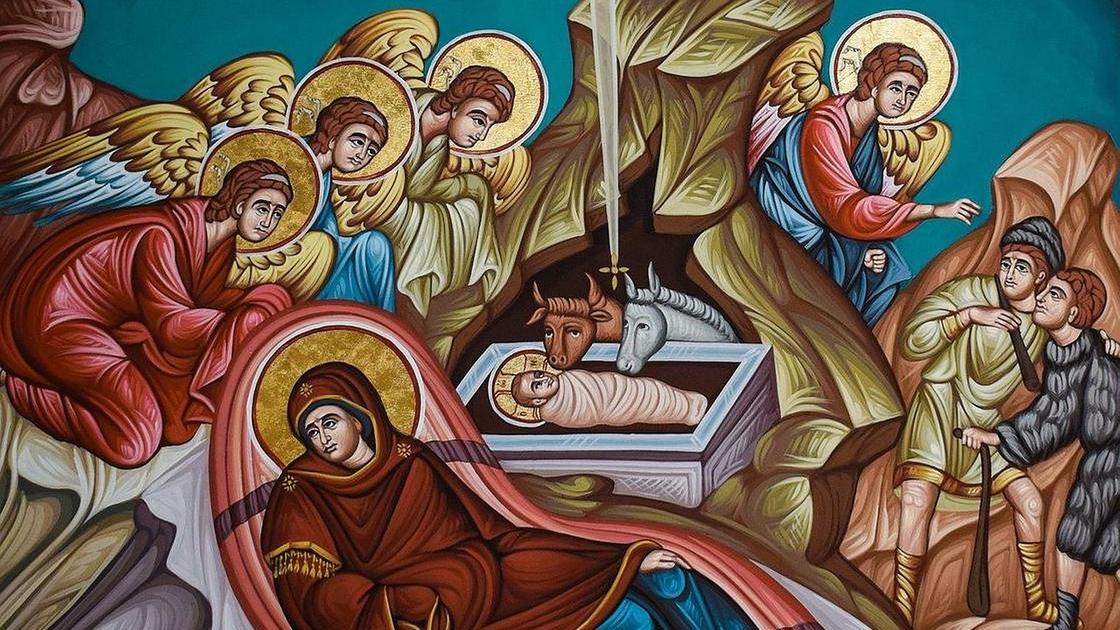
Рождество Христово — поворотный момент в истории человечества, с которого началось новое летоисчисление, новая эра. В христианской церкви это один из величайших праздников, ритуальное торжество и таинство. Народная традиция наполнила его особым благоговением, обрядностью и волшебством.
Праздник Рождества Христова
Когда Рождество Христово в православии? Христиане восточного обряда отмечают Рождество 7 января в отличие от католического, которое празднуют 25 декабря. Так произошло из-за разницы исчисления в юлианском и григорианском календарях — православная церковь не перешла на новый календарь. В ряде стран, где живут рядом православные и католики, Рождество отмечают в обе даты. В Казахстане Трудовой Кодекс (ст. 84) христианское Рождество (7 января) определил как выходной день.
История праздника Рождества Христова
Праздник посвящен событиям, которые описаны в Евангелии. Во времена царя Ирода проводилась перепись населения. Тогда у иудеев учет велся по коленам, племенам и родам. Иосиф, муж Марии, был из рода царя Давида, городом которого был Вифлеем. Туда и отправились Иосиф и Мария, там и пришло время ей родить младенца.
В Евангелии и в изложении Дмитрия Ростовского это произошло в пещере, в которой укрывали скот в непогоду. В городе не было другого места для ночлега из-за множества прибывших на перепись. Опираясь на свидетельства святых, автор пишет, что роды были безболезненными, Мария родила без помощи повитух, сама спеленала, положила в ясли, а затем поклонилась ему как Богу и Создателю.
Православный календарь сообщает, что в первые века христиане отмечали один праздник — Богоявление, в котором соединились рождение, поклонение волхвов и крещение Иисуса Христа. В IV веке Иоанн Златоуст называет Рождество очень древним праздником, выделил его. Первое упоминание даты рождения Иисуса Христа появилось в римском «Хронографе» 354 года. В том же веке произошло разделение на два больших праздника — Рождество и Крещение. При императоре Юстиниане (VI в.) празднование Рождества Христова было установлено везде, где проживали христиане.
В XVI веке, когда Европа перешла на григорианский календарь, даты празднования Рождества у православных и католиков стали разными.
В чем суть Рождества Христова?
Рождение Бога в человеческой природе — тайна, непостижимая для людей. Но само рождение — явление близкое и понятное. Для верующих христиан Рождество означает принятие Богом плоти человеческой, чтобы пройти земную жизнь, принять смерть ради спасения людей. Одновременно этот праздник означает рождение Бога в каждой христианской душе.
Кандидат богословских наук Иоанн Клименко поясняет, что Рождество — это не день рождения Иисуса Христа, но это изменение отношений человека с Богом и принципов существования. Бог, воплотившись в человеческую природу, освятил ее сущность, дал ей импульс жизни и надежду на спасение. Тогда, в эпоху глубокого духовного упадка человечества, это было очень важно.
Символы Рождества
В евангельском повествовании упоминаются явления, которые сопровождали рождение Иисуса Христа. Позже они стали традиционной символикой праздника:
- Вифлеемская звезда, которая возвестила рождение Христа и указала путь волхвам (восточным мудрецам и звездочетам) к месту его рождения. Восьмиконечная звезда стала украшением праздника Рождества.
- Рождественские подарки сохранились в память о священных дарах волхвов младенцу (золото, ладан и смирна).
- Рождественская елка стала символом вечной жизни. По преданию, родители младенца скрывали вход в пещеру еловыми ветвями. Традиция украшать дерево появилась впервые в германских землях в Средние века. Сейчас это непременный атрибут праздника, под которым размещают подарки.
Православные рождественские традиции
За века существования Рождество Христово обогатилось таким количеством традиций и обрядов, с каким не сравнятся обряды других праздников. Они стали значительным явлением культуры, отразились во множестве произведений. Этому посвящен целый сборник «Рождественские традиции. Рассказы, очерки, воспоминания».
Как встречать Рождество Христово?
Подготовка к Рождеству состоит из традиционных этапов и обрядов:
- Ему предшествует 40-дневный пост (с 28 ноября до 6 января). Главное в эти дни — духовное очищение, покаяние как дары Спасителю. Верующие готовятся к исповеди и причастию.
- В сочельник, или Святой вечер, накануне Рождества (6 января) до появления первой звезды старались ничего не есть. Вечером зажигали в окне свечу как символ ожидания Бога и открытой для него души.
- В сочельник еще соблюдается пост, для семейного ужина готовят соответствующие блюда. Главное на столе — кутья из распаренных зерен пшеницы, ячменя с медом, маком, изюмом. Готовят также овощные салаты, рыбу, пироги, вареники, взвар из сухофруктов.
- После семейного ужина молодежь и дети отправляются к родственникам, соседям с колядками, в которых славят Христа, поздравляют с его рождением, а также приносят добрые пожелания хозяевам. Ходят группами, иногда готовят театрализованные сценки рождественской тематики, в костюмах, с главным символом праздника — звездой. Хозяева одаривают колядников выпечкой и сладостями.
Что делают на Рождество Христово?
В ночь на Рождество в православных храмах проводится торжественное богослужение, которое отличается от всех других праздников. При этом поется ангельская песня как благодарность Богу за воплощение в человеческой природе. В народе сложились такие традиции праздника:
- Принято приветствовать друг друга словами «Христос родился!», а в ответ на приветствие говорить «Славим его!».
- Радостное настроение создают рождественские подарки родным и близким как воспоминание о дарах волхвов младенцу Христу.
- В особых вертепных театрах для зрителей разыгрываются представления, повествующие о евангельских событиях.
Рождественским утром наступает разговение после поста. Что приготовить на Рождество Христово? К празднику готовили уже обильные мясные и другие традиционные блюда:
- Из свинины — колбасы, запеченную свиную голову, студень.
- Запекали птицу с яблоками.
- Готовили жаркое из зайца и другой дичи.
- Пироги, кулебяки и другую выпечку теперь уже делали с мясной начинкой.
- Сладкая выпечка с традиционными напитками — взваром, киселем, сбитнем.
Празднование Рождества не заканчивалось 7 января, дальше наступали Святки до самого Крещения 19 января. Первый день после Рождества посвящается Богородице. Во все вечера Святок проводились магические обряды, гадания. Этот праздничный период был пограничным между хозяйственными годами.
Что нельзя делать в Рождество Христово?
В знак особого почитания праздника в народе сложились запреты на день Рождества:
- Нельзя ссориться, ругаться и сквернословить, особенно за праздничным столом.
- Нельзя отказывать в помощи нуждающимся и тем, кто обращается за ней.
- Не рекомендуется надевать старую или темную одежду.
- Нельзя заниматься будничными делами. Вся домашняя работа (уборка, стирка, а также шитье) должна быть закончена до вечера.
- За праздничным столом нельзя оставить нетронутым ни одно блюдо.
Время внесло коррективы в празднование Рождества, но многие соблюдают и хранят давние традиции, которые складывались веками. Они дают возможность приобщиться к духовным ценностям народа.
Оригинал статьи: https://www.nur.kz/leisure/holidays/1832084-rozdestvo-hristovo-tradicii-prazdnika/
Содержание
- Праздник Рождество в России бывает раз в году
- Какого числа отмечают праздник Рождество Христово в России
- Праздник Рождество в России. Дед Мороз и Снегурочка на празднике рождества
- Обычаи и традиции на празднике Рождество Христово
- Приметы на день Рождества Христова
Праздник Рождество в России бывает раз в году
Сегодня 31 Января 2023 вторник. Сегодня будет фаза луны Растущая луна и считается что сегодня 10, 11 лунный день. Восход луны будет в 11:38, а заход луны в 05:01. Луна сегодня будет в знаке зодиака Близнецы. По проверенным данным сегодня намечаются магнитные бури в диапазоне от 2 до 2 балловСегодня для огородников и садоводов благоприятный день ±+++Сегодня день благоприятный для совершении рабочих сделок, благоприятный для церемонии свадьбы, благоприятный для финансовых операций, благоприятный для проведения маникюра, для причесок
Растущая луна
11 лунный день
Восход луны 11:38
Закат луны 05:01
Видимость луны 66% на 12:00
Лунные сутки
- 10 лунные сутки 2023-01-31 11:38:00
- 11 лунные сутки До следующего дня
Фаза луны
Растущая луна
Луна в знаке зодиака
В знаке: Близнецы
Магнитные бури
—
В Соединенных Штатах рождественский сезон подходит к концу. Или завершается, в зависимости от того, с кем вы разговариваете. Самое прекрасное время года обычно заканчивается после празднования Нового года первого января. Православные христиане отмечают Рождество Христово — 7 января, а католики этот же праздник отмечают 25 декабря. Как католики отмечают рождество читайте на этой странице.
А ведь в России новогодние праздники только начинаются. Многие люди могут не знать, что 7 января в России отмечают Рождество Христово. Это праздник, отличный от тех, к которым привыкли многие католики.
Нам посчастливилось побывать за границей через Летний языковой институт Питтсбургского университета. И смогли узнать о некоторых обычаях русского Рождества. «Это большой религиозный праздник, — говорит москвичка Карина Музыка.
Какого числа отмечают праздник Рождество Христово в России
В Русской Православной Церкви 7 января считается важным праздником и одним из Двенадцати Великих праздников. Русское Рождество обычно начинается с первой звезды на ночном небе 6 января, что символизирует «рождение Христа и сигнал к началу рождественского обеда и святой вечери».
Празднование Рождества отличается от 25 декабря (католического Рождества Христова) тем, что Русская православная церковь — и большинство православных церквей — использует юлианский календарь для религиозных праздников вместо григорианского календаря.
Пересмотренное издание юлианского календаря было введено в 1923 году; это согласовало Рождество с григорианским календарем. Однако большинство православных стран не приняли это изменение, за исключением Греции, Кипра и Румынии.
Таким образом, существует 13-дневная разница между первоначальным юлианским календарем и современным григорианским календарем, который давно принят большинством западных стран, включая Соединенные Штаты.
Разница в датах — не единственное несоответствие между празднованием праздника в двух культурах. В России Рождество Христово считается меньшим и более тихим праздником, который следует за большим праздничным Новым годом.
Канун Нового года — праздник, обычаи которого больше всего напоминают Рождество в католических странах — пережиток ранне советского прошлого, когда большевистское руководство стремилось отвлечь внимание от религиозных обрядов на светские.
Новый год россияне празднуют едой, выпивкой и другими формами праздничного веселья. Это также день, когда Дед Мороз, русская версия Санта-Клауса, приносит детям подарки.
Праздник Рождество в России. Дед Мороз и Снегурочка на празднике рождества
У Деда Мороза нет конической шапки, связанной с Дедом Морозом, а вместо этого он носит круглую русскую шапку, отороченную мехом . Вместо этого его обычно изображают в длинном пальто в русском стиле, которое может быть красным, ледяным синим, серебряным или золотым, с подкладкой или оторочкой из белого меха.
Он носит посох, у него длинная белая борода и сапоги, чтобы держать ноги в тепле. Дедушка Мороз едет в традиционных русских санях, украшенных вечнозеленым деревом.
Примечательно, что для саней требуется всего три лошади — в отличие от коллеги Фроста с Северного полюса, которому нужно восемь оленей! Дом Деда Мороза находится в российском городе Великий Устюг, а не на Северном полюсе.
В пути за подарками Деда Мороза всегда сопровождает его внучка Снегурочка (Снегурочка) — уникальная черта легенды о Деде Морозе, не воспроизводимая в других культурах. Снегурочка — блондинка, румяная, одетая в длинное серебристо-голубое одеяние с меховой шапкой .
Существуют разные мнения о том, что влекут за собой современные рождественские обычаи в российском обществе. «У нас будет праздничный ужин, — говорит Настя Морозова, преподаватель и недавняя выпускница МГУ. — Но это все.
«Обычаи на Рождество связаны только с церковью, — сказала Музыка. «Однако в дни перед Рождеством существуют обычаи. Например, гадание».
Обычаи и традиции на празднике Рождество Христово
Гадание или Святки (Святки) — одна из популярных особенностей русского Рождества, хотя Церковь не одобряет это. Делается это обычно в канун Рождества, 6 января. По обычаю , для гадания должны присутствовать «темные силы», а место, где оно гадается, должно считаться «злым» и «грязным».
Примеры подходящих мест для гадания включают заброшенные дома, кладбища или, в прежние времена, бани. Другая традиция советует отправиться на перекресток, где можно встретить самого дьявола. Если ни один из этих вариантов не доступен, гадание может происходить в домашних условиях.
Все, что нужно сделать, это выключить свет, убрать и спрятать все иконы и религиозные образы, а также зажечь несколько свечей, прежде чем будут гадать. Состояние раскрывается с помощью таких методов, как чтение на кофейной гуще или поднесение свечи к зеркалу в темной комнате.
Русский рождественский ужин может начаться с молитвы и состоять из двенадцати различных блюд в честь двенадцати апостолов. В некоторых семьях обеды постные (без мяса), в то время как в других много мяса, такого как свинина, курица, оленина, баранина или гусь.
Главное блюдо, подаваемое во время святой вечери, — кутья — каша из цельного зерна, меда и мака.
Другая популярная рождественская кухня включает борщ , солянку , козули (русское рождественское печенье), часто сделанные в форме коз или оленей, и взвар , сладкий напиток из сухофруктов и меда, сваренный в воде.
После этого семьи могут пойти на полуночную церковную службу, а дети могут петь рождественские гимны в домах друзей и семьи. Часто колядующим дарят печенье, конфеты или деньги в знак признательности.
Итак, если в католических странах рождественский сезон завершился, то в России он только начался. Есть ряд культурных различий, но кажется, что одна общая тема — это дух товарищества, который приходит с семьей и, конечно же, с едой. С Рождеством Христовым! Счастливого Рождества!
Приметы на день Рождества Христова
07 Января 2023 — «Рождество»
Суббота
-
Если первым на Рождество переступит порог мужчина, это позволит избежать в семье ссор. Если первой вошла женщина – все женщины в семье будут болеть весь год. 0
-
Обилие снега – к благополучному году, оттепель – к ранней весне. 0
-
На Рождество Христово метель – пчелы хорошо роиться будут. 0
-
Если на Рождество путь хорош – к урожаю гречи. 0
-
Высокие сугробы предвещают благополучный год, а если оттепель – значит весна будет ранняя и теплая. 0
-
Ясная луна на небе – жди сильных морозов. 0
-
Рождество в воскресенье – к счастливому и благополучному году. В понедельник – к теплому лету. В пятницу – к затяжной зиме и холодному лету. 0
-
Если в этот день разбить посуду либо что–то разлить – это к ссоре. 0
-
посетить праздничное богослужение;
-
принято приглашать в дом гостей;
-
проявлять милосердие;
-
обязательно нужно приготовить кутью и еще 11 постных блюд;
-
разрешается есть рыбу, мясо, пить вино;
-
ходить в гости к друзьям и родным;
-
играть свадьбу;
-
нельзя гадать;
-
ходить в душ/ванную/баню;
-
заниматься хозяйскими делами и рукоделием;
-
напиваться алкоголем;
-
выносить мусор;
-
ругаться и ссориться;
-
до наступления Рождества со стола не убирают;
-
не принято надевать на праздник старую одежду;
Презентация на тему Рождество Христово
Сегодня вы узнали, когда отмечают Праздник Рождество в России, какие традиции с ним связанные. Если вам понравилась статья, ставьте лайки и пишите комментарии.
Возможно вам понравятся также следующие статьи:
Приметы на рождество для здоровья и удачи
Какой сегодня церковный праздник
Крещенский сочельник
Сретение Господне



